This is my simple, beginner-friendly guide to help you start affiliate marketing the right way. I’ve spent years earning online through affiliate marketing, following the same core steps: choose a niche that fits, sign up for affiliate programs, build a basic site or content hub, write helpful posts, drive traffic, and earn from every click or sale.
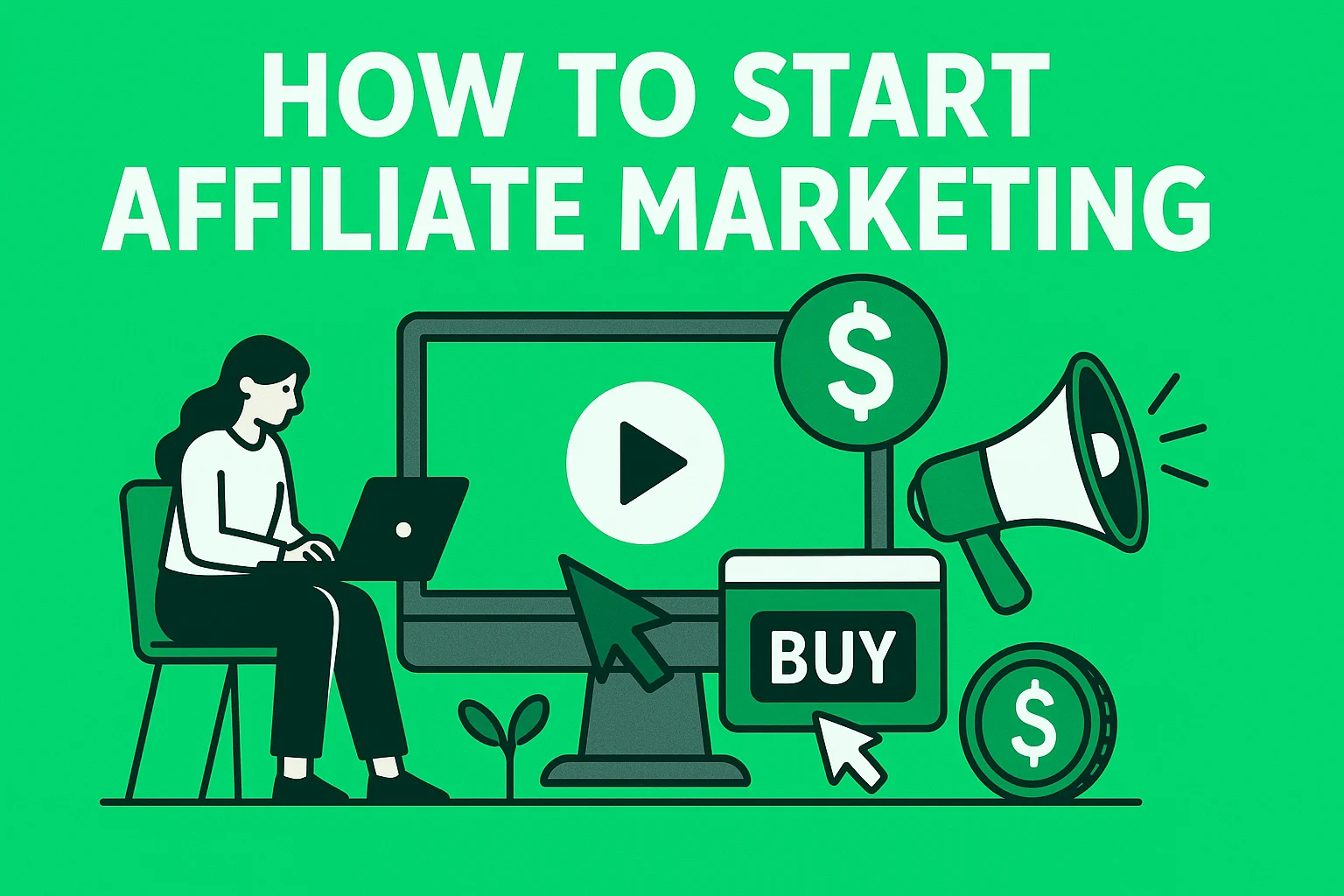
Welcome, friend! In this guide, I’ll walk you through how to start affiliate marketing from scratch even if you’ve never made a dollar online.
You’ll learn how to choose a niche, pick the right affiliate programs, set up your blog or website, write content that gets clicks, promote your links the right way, and build a solid setup that can actually make money as traffic grows.
How to Start Affiliate Marketing (and Make Money) in 6 Steps: Easy Beginner’s Guide
The Ultimate Beginner’s Guide to Start Affiliate Marketing and Make Money in 2025 (New Marketers)
Here is my quick story.
Before I found my way into digital marketing, affiliate marketing to be precise, I’d already tried several online gigs. I did academic writing, ghostwrote a few eBooks, and even tested survey sites and microtask platforms.
Some paid pennies, but most just drained me. I’d spend hours writing for clients who’d ghost halfway or suddenly “pause” the project without warning. Others got finished, sure…but I barely remember them. They felt like busy work, not real progress.
Then came the AI wave. It didn’t just shift the game; it slammed the door on the kind of freelance work I used to count on.
The space got noisy overnight. Clients I worked with for years started testing bots. Job boards got filled with lowball offers and automated proposals. The good gigs? Snatched up in seconds. I’d refresh a listing, and it’d already have 50 bids.
What once felt like a career started feeling like a fight to stay visible.
I gave it another thought, and it became clear that I needed something smarter. Something scalable. Something that didn’t trade time for money. That’s how I found affiliate marketing.
I still remember how clueless I was when I started. No product. No audience. No real budget. But I made my first $100 online just by helping people find something they already needed and showing them where to get it.
Now, I help beginners and side hustlers do the same without wasting months jumping from video to video or trying every random affiliate hack out there. This guide is built from real experience and real results.
Here’s what you’ll learn:
- What affiliate marketing really is and how it works
- How to pick the right niche without second-guessing
- Where to find affiliate programs that actually pay
- How to build a simple blog or content hub
- How to create posts that get clicks and earn trust
- How to drive real traffic without paying for ads
- How to track results and grow your earnings
- Best tools for affiliate marketing
- Mistakes most beginners make (and how to avoid them)
This is for anyone who’s serious about starting but doesn’t know where to begin. Maybe you’ve tried blogging. Maybe you’ve posted links online and nothing worked. Or maybe you’ve been stuck in research mode for weeks.
That’s fine.
We’re starting fresh, and I’m walking you through it.
This guide is for:
- Complete beginners
- Aspiring side-hustlers
- Bloggers ready to monetize
- Content creators looking for passive income
- Anyone tired of chasing low-paying gigs online
I won’t promise overnight success. But I will show you what actually works. Affiliate marketing gave me time freedom, income stability, and a way to build assets instead of just hustling for paychecks.
If that sounds like something you want too, then this is where it begins. One step at a time. No hype. Just what actually works right now.
Key Takeaways:
- You don’t need to be an expert to start affiliate marketing.
- Choosing a niche is the most important first step.
- Focus on solving real problems, not chasing trends.
- A simple blog or funnel can be more powerful than social media.
- Honest content builds trust, and trust brings clicks.
- Affiliate links should feel helpful, not spammy.
- Traffic doesn’t mean money but targeted traffic does.
- Start with organic methods, then scale with paid if needed.
- Track everything, but don’t obsess over it daily.
- Stay consistent. Most give up before they see results.
What Is Affiliate Marketing and How Does It Work?
Affiliate marketing is simple. You recommend someone else’s product or service online. When someone buys through your link, you earn a commission. That’s it.
You don’t handle inventory. You don’t deal with customer support. You’re not creating the product. You’re just the connector whose work is to point or simply direct people to something that solves a problem for them.
For example,
Let’s say your friend is looking for a budget laptop. You send them an Amazon link to the one you use and love. They buy it, and you get a small cut from that sale. That’s affiliate marketing.
And yes, big companies like Amazon, Walmart, and Booking.com run affiliate programs like this every day.
I’ve done the same, but only on a larger scale. Instead of sending links to one person, I share content (like blog posts or videos) that helps hundreds or thousands of people make buying decisions. The more people who click and buy, the more I earn.
Different Types of Affiliate Marketing
Back in 2009, Pat Flynn explained types of affiliate marketing in a way that stuck with me. He talked about three types, and once you see them, you can’t unsee them.
First, there is unattached affiliate marketing. There is no face and there is no name, with links floating around in ads. Trust is rarely built in this approach, and the hope is simply that someone clicks and buys. It can work, but the method feels cold and distant.
Then you’ve got related affiliate marketing. This is where most people start. You’re in the niche, maybe you’ve used the product, maybe not. But you’ve got an audience and the product fits. There’s some connection, but it’s not deep.
And finally, involved affiliate marketing. This is where you’ve used the product yourself. You believe in it. You’d recommend it even if there were no commission. People trust you because you’ve lived it. That’s the kind of marketing that sticks, and the kind I aim for.
If you want long-term results, focus on the “involved” model. That’s what I teach and use.
Recommended Reading: 7 Types of Affiliate Marketing (And Which One Actually Pays Beginners Fast)
How Do Commissions Work?
Every affiliate program sets its own rules. Some pay a flat fee per sale. Others give you a percentage. Some only pay if the person buys right away. Others offer “cookie windows” (like 30 or 60 days) where you still get paid even if the person comes back later.
If you want a full breakdown of how payouts actually work, check out my other post on: Understanding the Affiliate Commission Structure: What It Is and How It Works. I break it all down in plain language.
Who’s Involved in Affiliate Marketing?
Affiliate marketing isn’t a solo game. Behind every sale, there’s a system at work, even if it looks simple on the surface. It’s not just you grabbing a link and posting it online. There are other people in play, each with a role in making it all happen.
So who’s actually involved? There are usually four key players:
- The Merchant: This is the company or creator with something to sell. Could be a big brand, a solo creator, or anyone in between.(e.g., Amazon, Bluehost, ConvertKit).
- The Affiliate: That’s the person (or team) promoting the product. They earn a cut when someone buys through their link.
- The Network (optional): This is the middleman. A platform that tracks the sales, handles the links, and sometimes pays out commissions. Not always part of the mix, but often involved. (like ShareASale or CJ).
- The Customer: The person who clicks the link and makes the purchase. They don’t pay extra, they just help complete the cycle.
The Affiliate Value Chain (Simple Breakdown)
Here’s a simple breakdown of what the whole thing looks like:
- You sign up for an affiliate program
- You get your unique link
- You create content or share that link (via blog, email, YouTube, social, etc.)
- Someone clicks your link
- They land on the product/service page
- They buy the product/service
- The sale is tracked, and you get paid
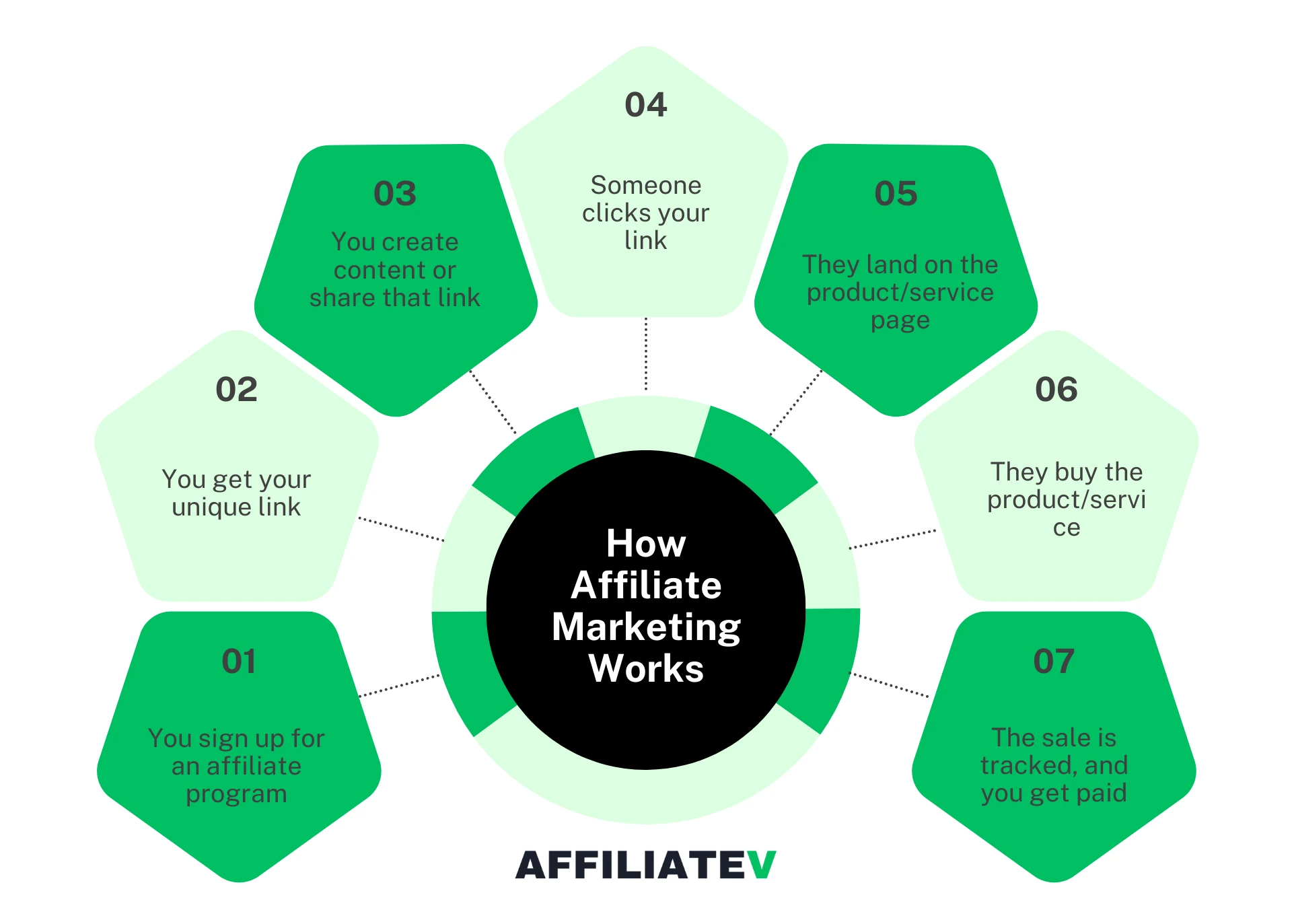
That’s the flow, just as simple as that.
Is Affiliate Marketing Still Worth It in 2025?
If you’re asking this question, you’re not alone. A lot of people are wondering if affiliate marketing still has room for beginners or if the gold rush is over. I get it. The online space looks crowded. Google’s gotten stricter. AI is everywhere.
But here’s the truth:
Affiliate marketing hasn’t died, it’s just grown up.
Years ago, anyone could slap up a blog post, drop in some Amazon links, and rank overnight. That doesn’t work anymore. Things have changed. What’s working today is different, but not impossible. If you focus on helping, not selling, and treat this like a real business, there’s still space to win.
Let’s break it down.
So, What’s Actually Working Right Now?
Most of what worked five or ten years ago still works, but with a twist. Google now favors depth, trust, and actual helpfulness. If you’re just spinning articles with AI or writing what everyone else is writing, you’ll struggle.
But if you’re sharing your personal experience, answering real questions, and giving people reasons to trust you, you’ll rise above the noise.
Here’s what continues to work well in 2025 and beyond:
- Content that’s genuinely helpful, not just keyword-stuffed
- Personal reviews and tutorials from actual use
- Email lists paired with SEO content
- YouTube or short-form videos explaining products
- Human-first writing. Clear, personal, and relatable
None of this is magic. But it works if you stay consistent and care about the person reading your content.
What’s Changed and What’s Still Evolving
The affiliate space hasn’t stopped growing, it’s just shifted. AI tools now help content creators move faster. That’s good and bad. It helps with structure, but it also means more generic content out there. What cuts through? Being you. Being real and having an opinion. Sharing what worked (or didn’t) for you.
Another shift is that people now expect transparency. They’re tired of shallow “top 10” lists. They want helpful details, what makes something worth buying, where it fails, and how it compares. Now, the biggest change is that you need to build trust first. Selling comes later.
New Niches and Fresh Angles to Explore
If you think all the good niches are taken, think again. The top-level categories might be competitive, but within each are micro-niches full of opportunity. The more specific and relatable your focus, the better your odds of standing out.
Some areas gaining traction in 2025:
- AI tools for freelancers, solopreneurs, and creators
- Eco-friendly products and sustainable living
- Local affiliate marketing (think: services, events, tourism)
- Remote work tools, creator platforms, and solopreneur stacks
- Affiliate programs tied to online education and micro-courses
Go where your curiosity is, where you understand the topic well. If something interests you, there’s a good chance others are looking for it too.
The Honest Pros and Cons of Affiliate Marketing in 2025
Honestly, this model isn’t a get-rich-quick setup. It takes time, effort, consistency, and patience. But if you want to build something that can earn while you sleep (eventually), the pros still outweigh the cons only if you go in with the right mindset.
Here’s a straight-up view:
| Pros | Cons |
|---|---|
| Low startup cost (you can start with under $100) | Takes time to build traffic and trust |
| No need to create your own product | High competition in broad niches |
| Works with blogs, videos, emails, and social | Algorithm updates can affect traffic |
| Potential for recurring passive income | Some affiliate programs cut or change payouts |
| You own your platform (blog/email = control) | Lazy content doesn’t work anymore |
| Unlimited income ceiling with the right content | Requires ongoing effort to grow and adapt |
What the Data Says
Don’t just take my word for it. The numbers back this up. According to Statista, affiliate marketing spending in the U.S. has risen steadily over the years and is projected to reach $13 billion by the end of 2025, up from $8.2 billion in 2022. This means a great opportunity.
Honestly, that’s not slowing down.

In addition, over 80% of brands now use affiliate marketing as part of their sales strategy, and 84% of content publishers use it to monetize their traffic (source: Rakuten Marketing).
That’s not a dying model. That’s a growing one.
If you’re willing to focus on quality, tell the truth, and stick with it, you’ll stand out. Not because you’ve gamed the system. But because you’re doing something that still matters: helping someone make a better decision online.
How Much Money Can You Make With Affiliate Marketing?
How much you make in affiliate marketing depends on a few things, like your niche, your traffic, and how well you earn trust.
I’ve seen people make their first $100 in a month. Others hit $1K consistently in under a year. And yes, there are folks like Tom Dupuis from onlinemediamasters.com pulling in six figures monthly, but remember that’s not overnight stuff. That’s time, strategy, and showing up even when it’s slow.
Authority Hacker’s survey shows that affiliate marketers make an average of $8,038 each month. But if you’re just starting and have less than a year of experience, you’re more likely to be around the $636 per month mark.

If you treat it like a real business, not just a weekend side hustle, you can grow real income from it. I’m not talking about get-rich-quick hype. I’m talking about building content that helps people, testing what works, and staying in the game.
Some links might earn you a few bucks. Others? You wake up to a $250 commission from one blog post you wrote weeks ago. It stacks up if you stick with it.
Follow These 6 Steps to Start Affiliate Marketing and Make Money Online as a Complete Beginner:
Starting affiliate marketing can feel overwhelming, especially if you’ve never done it before. But it doesn’t have to be. You don’t need a big budget, fancy tools, or years of experience. What you do need is a clear path to follow.
Here are 6 simple steps to help you start affiliate marketing from scratch and actually make money doing it.
Step 1: Choose a Niche That Pays and Feels Right
Most beginners get stuck here, not because they lack ideas, but because they chase the so-called “perfect” or “hot” ones. A perfect niche does not exist. Every niche you pick will depend on your interests, skills, and the audience you want to reach.
The key is choosing one you can stick with long enough to grow and one that actually has a good earning potential.
How to Find the Best Niche that Fits You
The infographic below breaks down what makes a niche truly worth your time as an affiliate marketer. You’re not just picking a topic. You’re looking for the Best mix of long-term potential, market need, and personal drive.
Let’s walk through the five key traits:
1. Evergreen
You want a topic that stays relevant. Think health, money, or relationships…stuff people always care about. Avoid fads or trends that die off fast. Instead, create content that people can still use and search for years later.
2. Passion
If you’re going to stick with something for the long haul, you’d better enjoy it. When you’re passionate, you speak with more energy. It’s easier to show up consistently and connect with your audience in a real way.
3. High Demand
There’s no point picking a topic no one’s searching for. Use tools like Google Keyword Planner or Ubersuggest to see what people are already looking for. Also, dig through forums and marketplaces to see real buyer interest and questions.
4. Good Affiliate Offers
A niche is only profitable if it has the right products to promote. Look for programs that offer strong commissions and don’t get a ton of refunds. It helps if the products are actually useful—you want to feel good recommending them.
5. Low Competition
Don’t fight giants when you’re just getting started. Go after smaller, specific niches (long-tail keywords). Tools like KWFinder or LowFruits can help you find areas where you can rank and stand out faster.
Here’s a clear illustration,
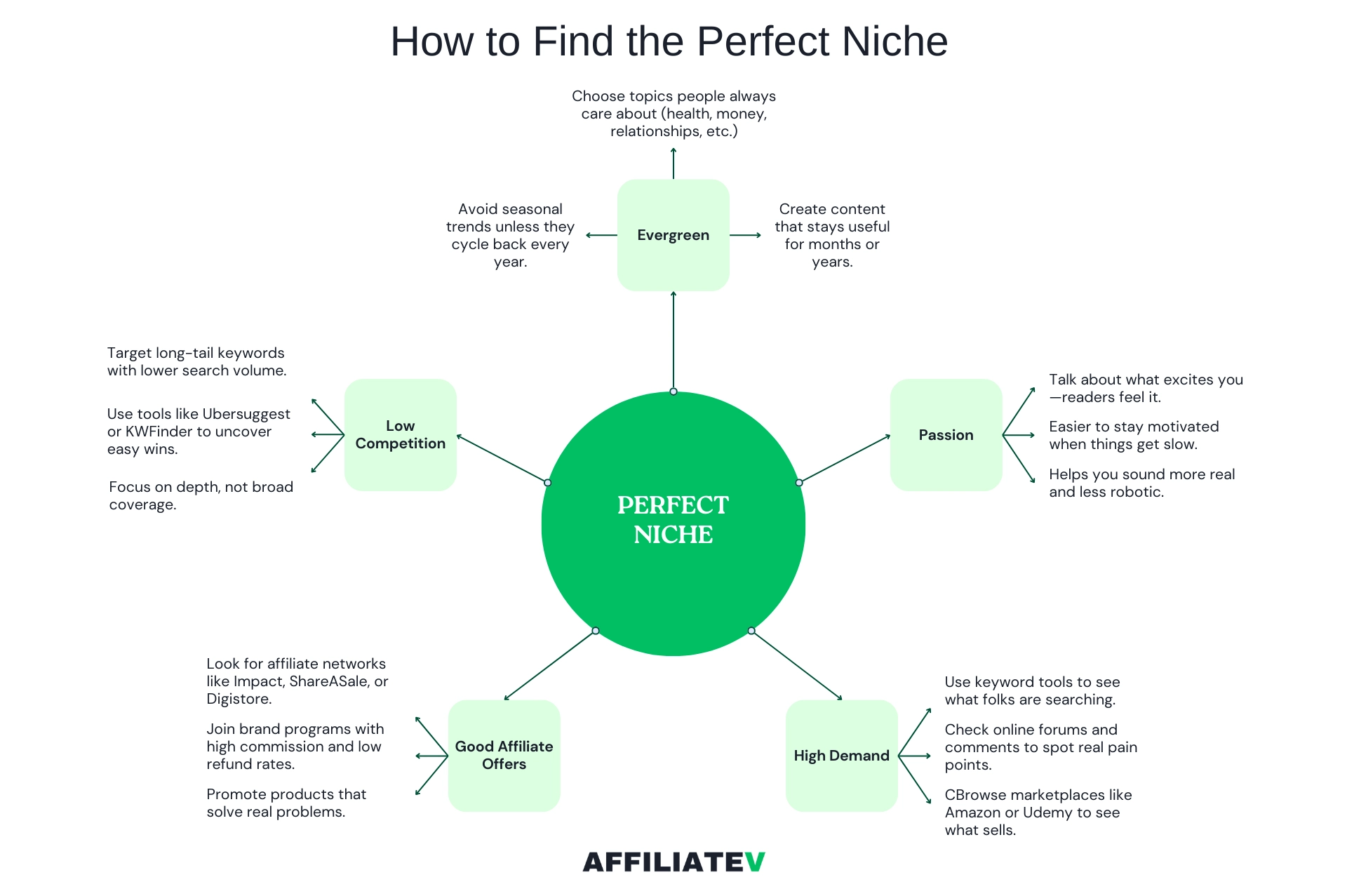
Put all five together, and you’re no longer guessing; you’re choosing a niche that gives you staying power, real income potential, and content you’ll actually enjoy creating.
Now, let’s talk about profit vs passion: why you need both
In simple terms, a good niche should sit at the intersection of your curiosity and people’s problems. That’s the sweet spot. If you’re even a little interested in the topic, it’ll be easier to stay consistent. And if that topic solves a problem others are already spending money on, you’ve found something worth your time.
Find a space where your curiosity overlaps with other people’s needs.
For me, affiliate marketing clicked because I loved writing and already spent hours digging into tools, tech, and online business ideas. I just didn’t know I could earn from sharing what I already knew.
Quick niche research method (Google, Amazon, Reddit, YouTube)
Start by doing what I call quick-and-dirty niche research. Type your idea into Google and see what blogs or websites come up. Look at what’s ranking.
Then go to Amazon and browse the bestsellers related to that topic. Jump into Reddit threads and notice the recurring questions or complaints.
YouTube’s comment sections are also goldmines, see what content people love and what they’re asking for. You’re not trying to be fancy here. You’re just spotting patterns.
If a topic keeps popping up, it likely has a built-in demand.
Evergreen niches vs trending ones
Now, here’s something most people miss. Understanding the type of niche they’re stepping into. Some are evergreen. These never go out of style. Think niches like personal finance, health, productivity, and parenting. Others are trend-driven, like the latest AI tools, crypto updates, or buzzy side hustles.
Evergreen gives you stability; trends can give you quick wins, but may dry up fast.
If you’re unsure where to begin, don’t overcomplicate it. Solid niches in 2025 still include things like tech tools, wellness products, online business ideas, budgeting tips, and side hustle content.
People always want to save time, make more money, or feel better. So, niches that serve any of those needs are usually a good bet.
To help you skip the guesswork, I have put together 10 of the best niches for affiliate marketing in 2025. Ones worth your time and energy.
How to check if a niche has affiliate programs
But before you settle, check if the niche actually has affiliate programs. That’s a non-negotiable. Just type something like “fitness affiliate programs” or “productivity tools affiliate program” into Google. You’ll find results fast.
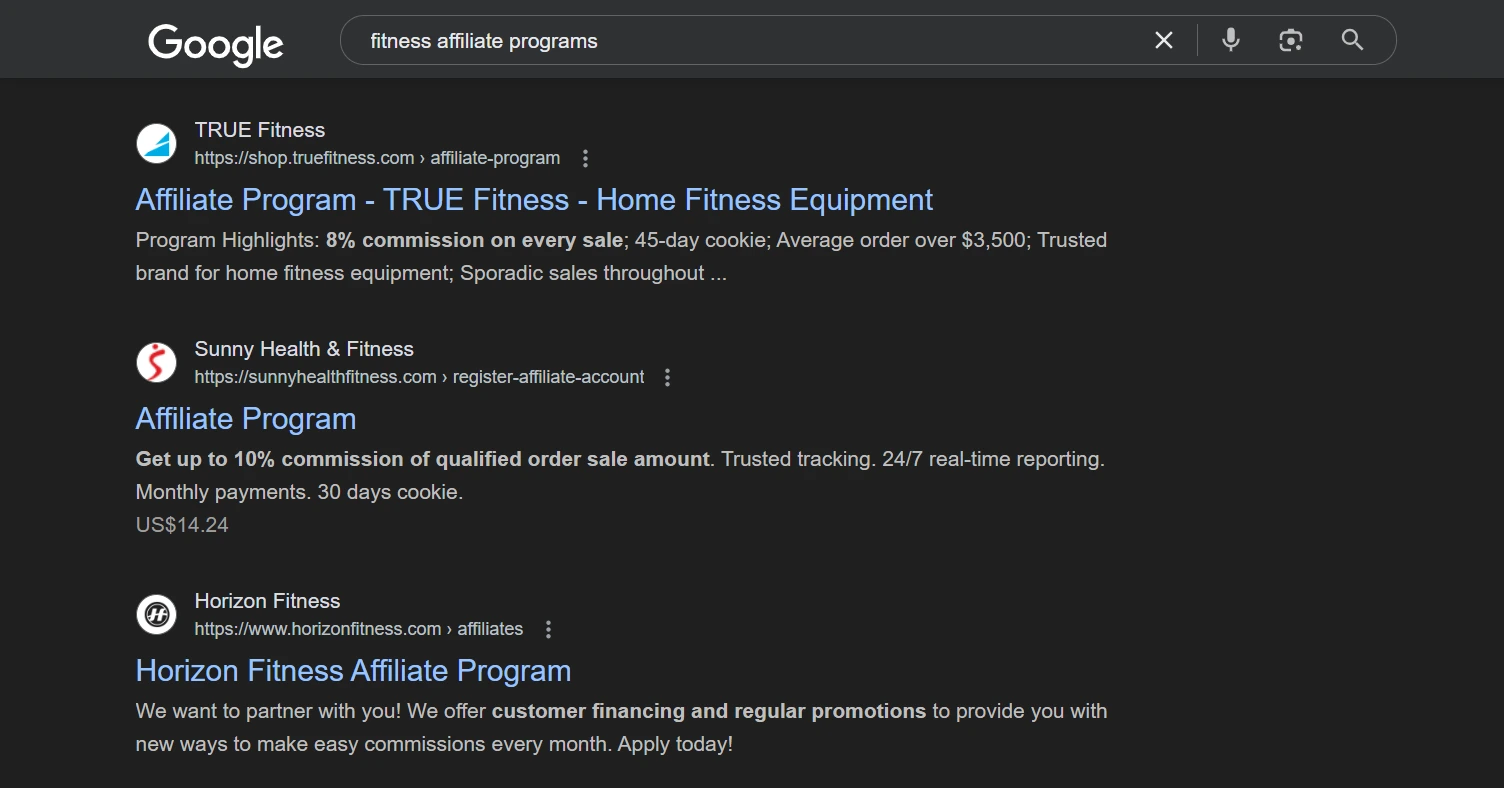
Platforms like ShareASale, Impact, Digistore24, and PartnerStack can also give you a clear look at what’s available. If you find yourself struggling to locate offers that feel right to promote, take that as a sign to pause and reassess.
My honest advice? Pick a niche you won’t get tired of. Not because it’s trendy or hyped, but because it genuinely grabs your attention. When I chose mine (affiliate marketing), it wasn’t because I thought it was a shortcut to riches. I just found myself reading about it late at night, testing ideas, using the tools, and wanting to figure it out. That curiosity kept me going.
Let your interest guide you, but back it up with clear signs that people are buying. That’s how you build something that lasts.
Now, let’s find the affiliate programs that make sense for your niche.
Step 2: Find Affiliate Programs to Join
You’ve nailed down your niche. That’s your starting point, but remember you’re not in business yet. You still need something to promote. That’s where affiliate programs come in. These programs give you a special link, and when someone clicks that link and buys (or signs up), you get paid.
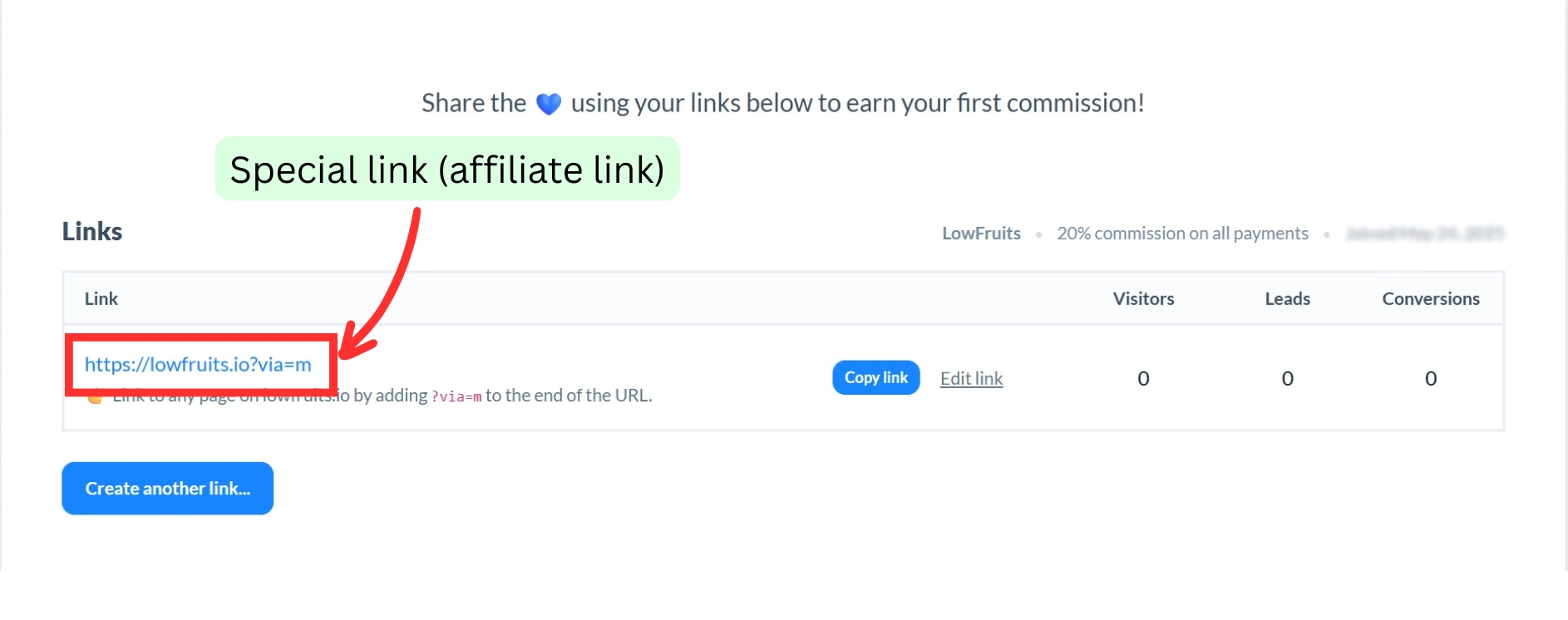
Now, not all affiliate programs are created the same. Some are a complete waste of time: low payouts, poor tracking, and shady terms. Others are goldmines, with good commissions and strong support. You just need to know what to look for and where to find them.
Let’s break it down.
Types of Affiliate Programs
Different affiliate programs work in different ways. Understanding this will help you pick offers that actually fit how you want to earn.
1. High-ticket affiliate programs pay big, which is usually $100 or more per sale. These often promote expensive software, courses, or coaching services. You won’t get a lot of volume, but one sale can be worth ten smaller ones. It’s a solid choice if you can build trust and explain value clearly.
2. Recurring affiliate programs are my favorite. You earn a commission every month your referral keeps using the product. Think tools like email marketing software (like GetResponse), membership platforms, or SEO tools. If you’re building long-term income, this is where the magic happens.
3. Pay-per-lead programs pay you even if no one buys anything. You earn when someone fills out a form, books a free trial, or just signs up. These are great if you’re in niches like finance, insurance, or education, where leads are more valuable than sales.
Ideally, mix one or two of each type into your strategy. That way, you’re not relying on just one type of commission.
How to Find Affiliate Programs
Now let’s talk about where to look. It’s way simpler than most people think.
1. Use Google Search
Start with a basic Google search. Literally type:
“[your niche] + affiliate program”
Let’s say your niche is productivity tools. Just Google:
“productivity tools affiliate programs”
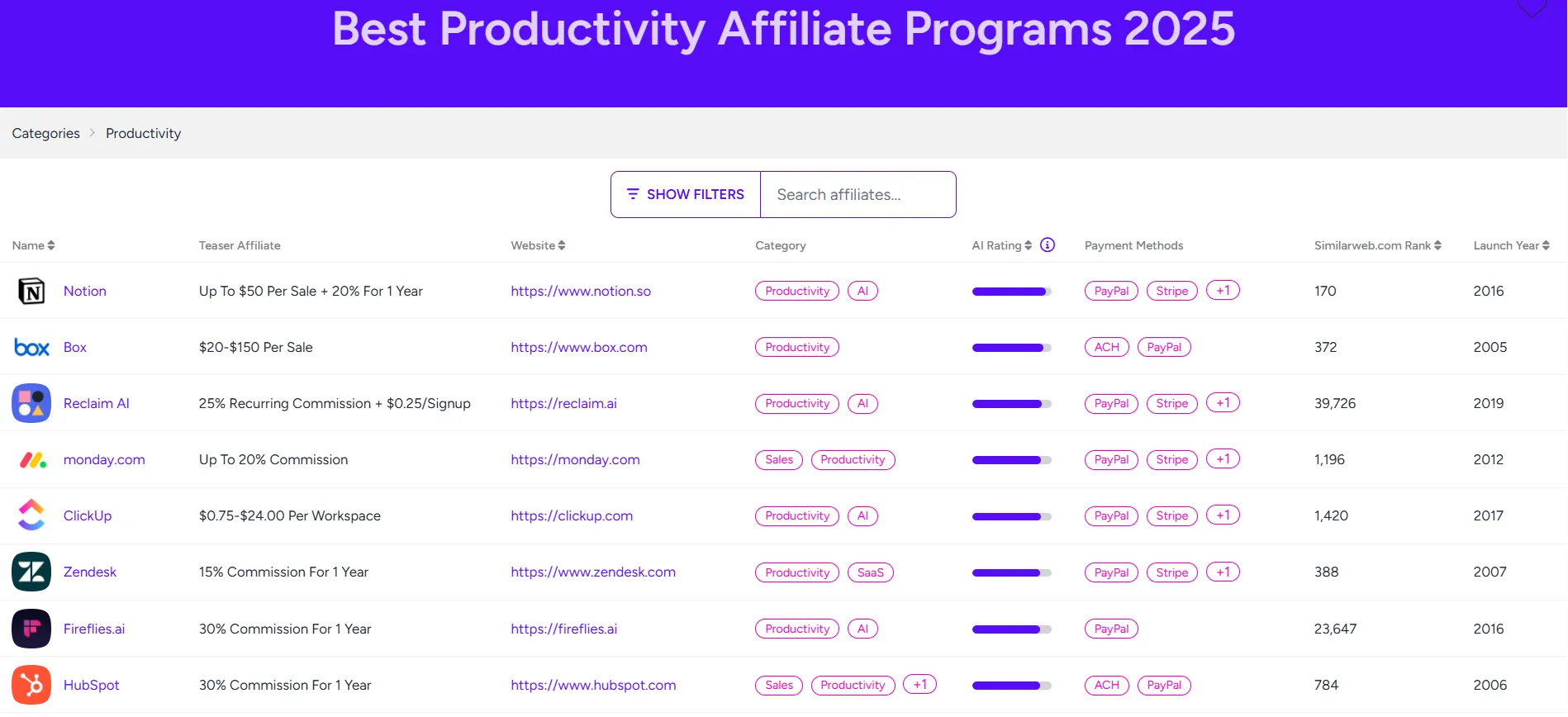
You’ll get a list of programs with direct signups. Scroll to the bottom of those websites and look for a link that says “Affiliate,” “Partners,” or “Refer & Earn.” Most legit companies host their own affiliate programs right there.
You can also check the sites of tools you already use and love. If you’d recommend them anyway, they’re the perfect fit.
2. Use Affiliate Networks to Save Time
If hunting down individual affiliate programs sounds like a lot, there’s an easier way to go about it: affiliate networks.
These are platforms that connect you with thousands of brands and offers in one place. You apply once and can promote multiple offers across different niches.
Here are a few beginner-friendly ones I trust:
- ShareASale – huge variety and good for beginners
- Impact – clean interface, big-name brands
- CJ Affiliate (Commission Junction) – more established, lots of global offers
- PartnerStack – focused on SaaS tools
- ClickBank – great for digital products and courses
- Digistore24 – mix of physical and digital offers
Each has its own style, but you’ll find something in every niche. I’ve used all of them over the years. If you want to compare them side by side, I broke everything down here: 15 Best Affiliate Networks That Actually Pay: My Personal Picks After Years in the Game
3. Affiliate Program Directories
If you want more options or don’t want to keep Googling manually, directories like affiliateprograms.com are a smart shortcut.
These are websites that list thousands of affiliate programs by category, niche, and payout type. Just search your niche, and you’ll see dozens of active programs with links to apply.
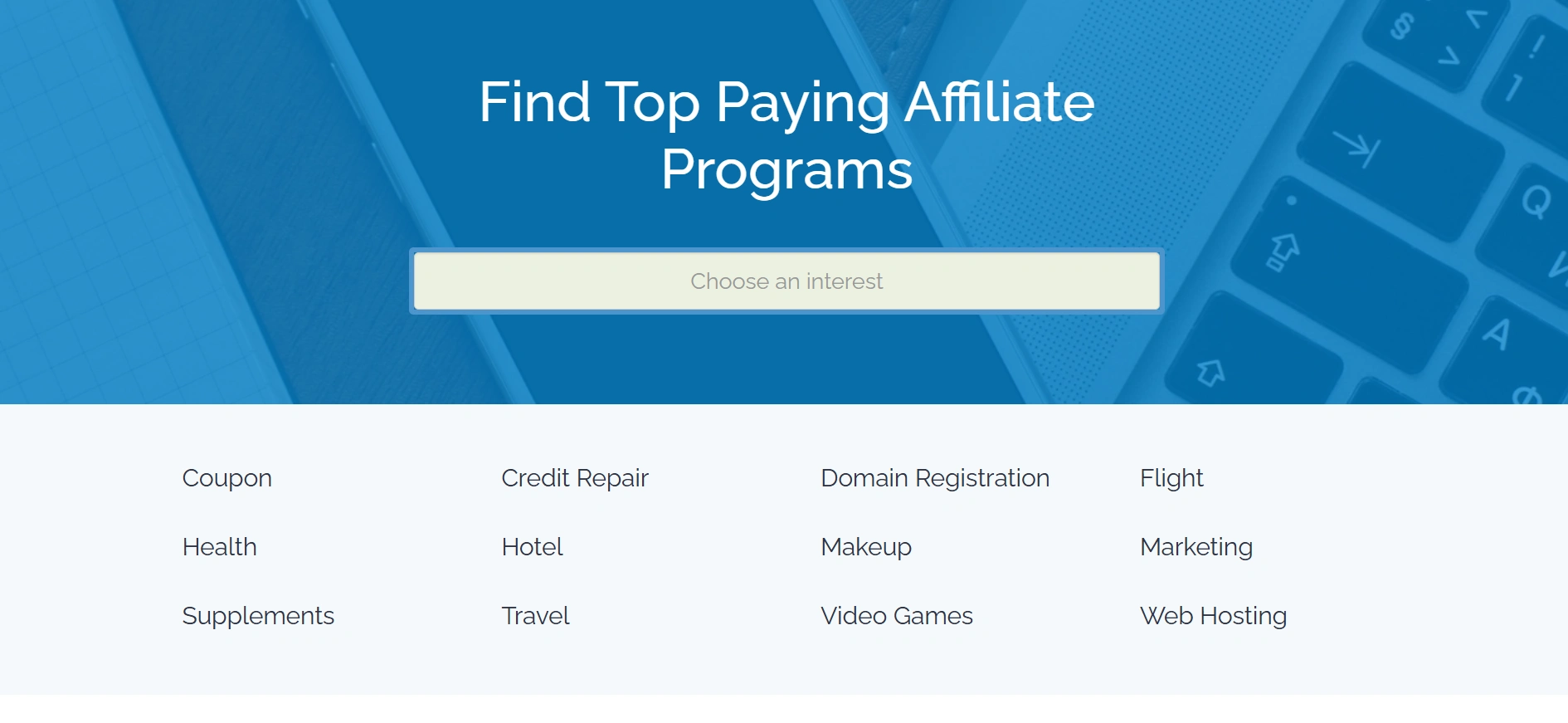
Here are a few you can check out:
- affi.io – clean layout, easy filtering
- Offervault – more advanced, with payout details
- AffiliatePrograms.com – solid for beginner-friendly offers
- FlexOffers – also a network, but has a searchable directory
- Rakuten Advertising – directory + network, works best for eCommerce
These sites are especially helpful when you’re exploring a new niche or trying to find alternatives to overly saturated programs.
How to Get Approved (Even If You’re New)
This part stresses a lot of beginners out, but getting approved doesn’t have to be hard.
You don’t need a fancy site or a big audience. What you need is a clear plan and a little bit of professionalism.
Here’s what helps:
- Use a domain email (like yourname@yourblog.com). It looks serious and shows you’re not just spamming links.
- Have a simple blog or landing page that explains what you’re doing, even if it’s just one or two posts to start.
- Be honest in your application. Don’t fake numbers. Just explain that you’re building a content hub around a specific niche and plan to offer helpful content.
- Avoid generic responses. A short personal message about how you’ll promote the product goes a long way.
If you still feel unsure, I wrote a detailed walkthrough here to make it easier: How to Apply and Get Approved by Affiliate Programs: A Step-by-Step Guide
Once you’re in, take your time testing offers. Don’t promote everything just to fill space. Pick tools or products you’d use yourself. Think about what your future readers will actually benefit from, and go from there.
Now that you’ve got products to promote, it’s time to build your blog or content hub to house everything.
Step 3: Build a Simple Website That Converts
Many beginners think they can skip this step and just promote affiliate links directly on social media. And sure, that works short-term. But if you’re serious about building something that earns for years, you honestly need a site.
A simple one. Not complicated. Just focused on helping people and turning clicks into commissions.
Your website is your home base. It builds trust, lets you control your content, and gives you space to grow. SEO, email, long-form content, product comparisons… all of that starts here.
Let me explain in more detail.
Why Having a Site Still Matters in 2025
It’s easy to assume TikTok and Instagram replaced websites. They didn’t.
A site gives you ownership. You don’t depend on an algorithm. You can collect emails, rank on Google, build authority, and guide people through content that solves their problem, not just entertains for 15 seconds.
Affiliate programs also love sites. You’re more likely to get accepted if you have one. It shows intent, focus, and that you’re in this for the long run. Brands take you more seriously when you have a legit online presence.
WordPress vs No-Code Options (Like Systeme.io)
If you’re not techy, don’t panic. These days, building a site is easy.
WordPress.org is still the best choice for most affiliates. I’d recommend it. It’s free, flexible, and you own everything. Tons of plugins, SEO tools, and full control. But there’s a slight learning curve.
If you want drag-and-drop simplicity, Systeme.io is a solid no-code option. It’s all-in-one: funnels, emails, and hosting in one place. I know people using it for lean affiliate sites and digital products. It’s not as powerful as WordPress, but it gets the job done if you want speed over depth.
If you’re going with Systeme.io, don’t miss this: use my code (AFFILIATEV10) at sign-up and get 10% off your first plan. It’s a nice bonus if you’re starting fresh and want to keep things simple and budget-friendly.
However, I still recommend WordPress for anyone who wants long-term growth and full customization.
Basic Pages You Need
You don’t need a massive website to start. What you need is clarity. Just 3 to 4 pages that tell people who you are, what you offer, and why they should trust you.
Let’s walk through what matters:
1. Home Page
This is your welcome mat. Keep it clean and simple. Say what your site is about in one sentence. For example: “Helping busy people find the best tools to work smarter.”
Include a short intro about you, what readers can expect, and link to your latest or most helpful content. Use headings that guide people. Avoid clutter. One goal: help them find value quickly.
2. About Page
This isn’t just about you. It’s about why someone should listen to you. Tell a quick story—why you got into the niche, what problems you faced, and what changed. Keep it honest.
People connect with people. If you’re real here, they’ll stick around longer. Also, this is one of the most visited pages on most blogs. Don’t skip it.
3. Blog Page
This is where all your content goes. You don’t have to call it “Blog” if that feels too bland—use something that fits your style.
Every review, how-to, roundup, or tutorial you write should show up here. It helps readers explore, and it shows search engines you’re active.
4. Disclaimer Page
This one’s not optional. It tells people you may earn a commission from your links. It builds trust and keeps things legal, especially with affiliate programs. Keep it clear, not robotic. Something like: “Some links on this site are affiliate links. If you buy through them, I may earn a small commission at no extra cost to you. I only recommend what I use or trust.”
Other Important Pages: Contact + Resources Pages
Once you’ve got a few posts live, add a contact page. Just a form or email so readers or partners can reach out. Later, build a “Resources” page listing tools or offers you recommend (this converts well if done right).
The key is to get started without overwhelm. Don’t wait for it to be perfect. Just set up these core pages so you look credible and ready for traffic. Add a contact page or resources page once you grow. But keep it lean at first. Just get your content live.
Tools You’ll Need and How to Set Up Your Site
Setting up your blog isn’t as technical as people make it sound. You only need a few core tools to get online fast and look clean.
Here’s what I use and why.
1. Domain Name
Think of your domain name as your digital storefront sign. It’s the first thing people see. It should look clean and feel easy. Avoid dashes, weird spellings, or anything you’ll have to spell out over the phone.
The Importance of Having a Domain Name:
- Builds trust instantly
- Easy to share on podcasts, social media, or offline
- A clean domain can improve click-through rates (CTR)
What to Watch Out For When Purchasing Your Domain Name:
- No dashes: For instance, tech-tools-online.com feels spammy. Use techtools.com instead, if you can.
- No tricky spellings: If someone asks you, “What’s your site again?” and you have to explain 3 times, that’s a problem.
- Avoid numbers unless it’s part of a brand (like 1440.com for the newsletter)
Here is a Quick Example: Vadis Wants to Start a Site
Let’s say Vadis wants to start an affiliate blog about AI tools for small business owners. He’s passionate about tech and wants to recommend the best tools for productivity, automation, and customer support.
Here’s how he might think through a domain:
Bad options:
- ai4smolbiz.net – Hard to read, confusing spelling, and .net is forgettable
- best-ai-tools-2025.com – Long, includes a year that will age fast
Good options:
- vadistechy.com – Personal, branded, flexible
- smartaistack.com – Niche-specific but clean
- toolwise.ai – Short, catchy, relevant
The key here is flexibility and clarity. Vadis might start with AI tools, but he may want to expand into other software later. So vadistechy.com gives him room to grow.
Where to Buy a Domain Name:
Here are the registrars I recommend.
- Namecheap – Great prices, no hard upsells
- Google Domains – Clean interface, straightforward pricing (Note: Now under Squarespace)
- Porkbun – Newer, but has honest pricing and privacy included
Steps for Vadis:
- Go to Namecheap
- Search for “vadistechy.com”
- Buy it (grab the .com if possible)
- Enable WHOIS privacy (usually free on Namecheap)
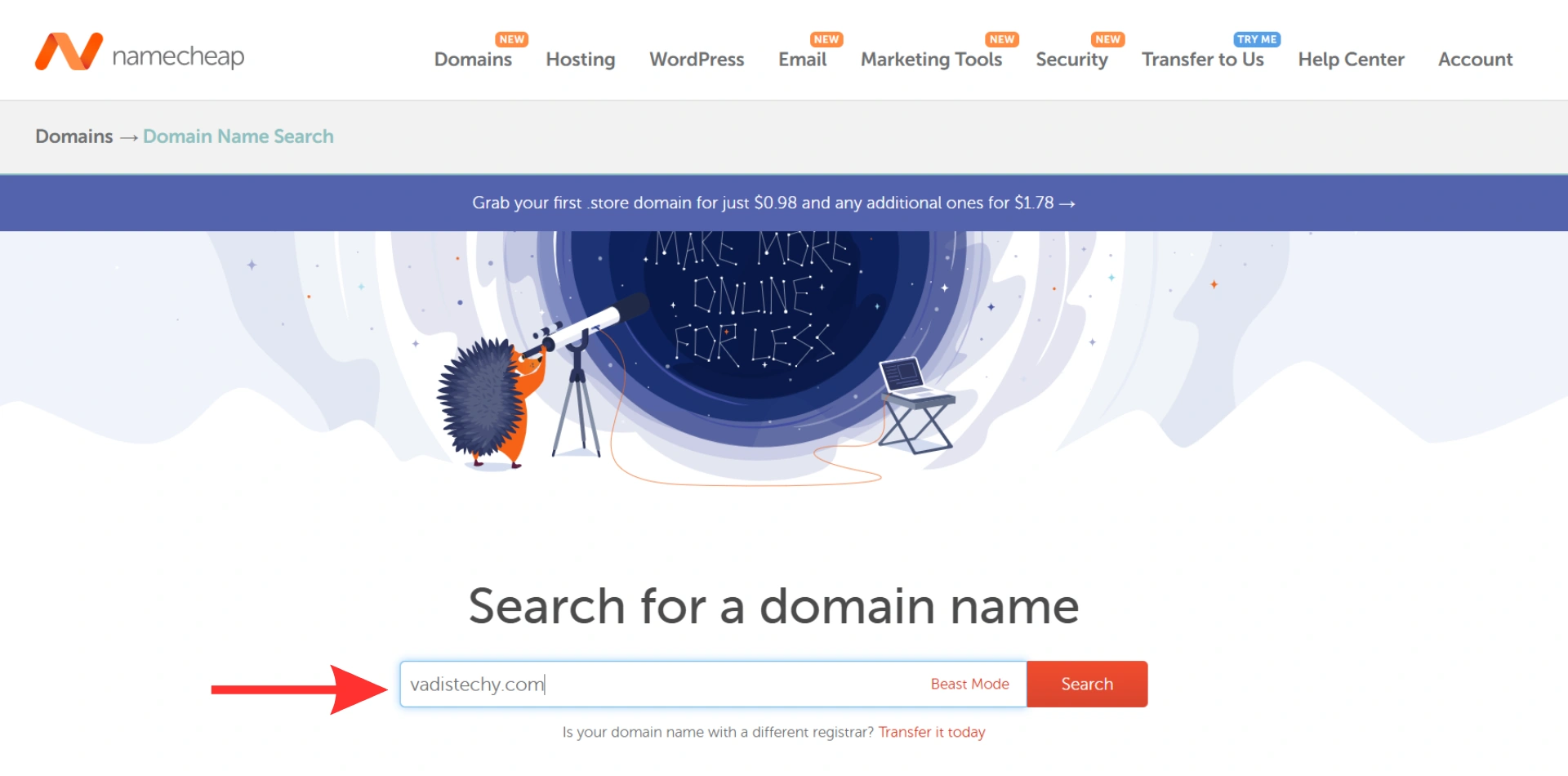
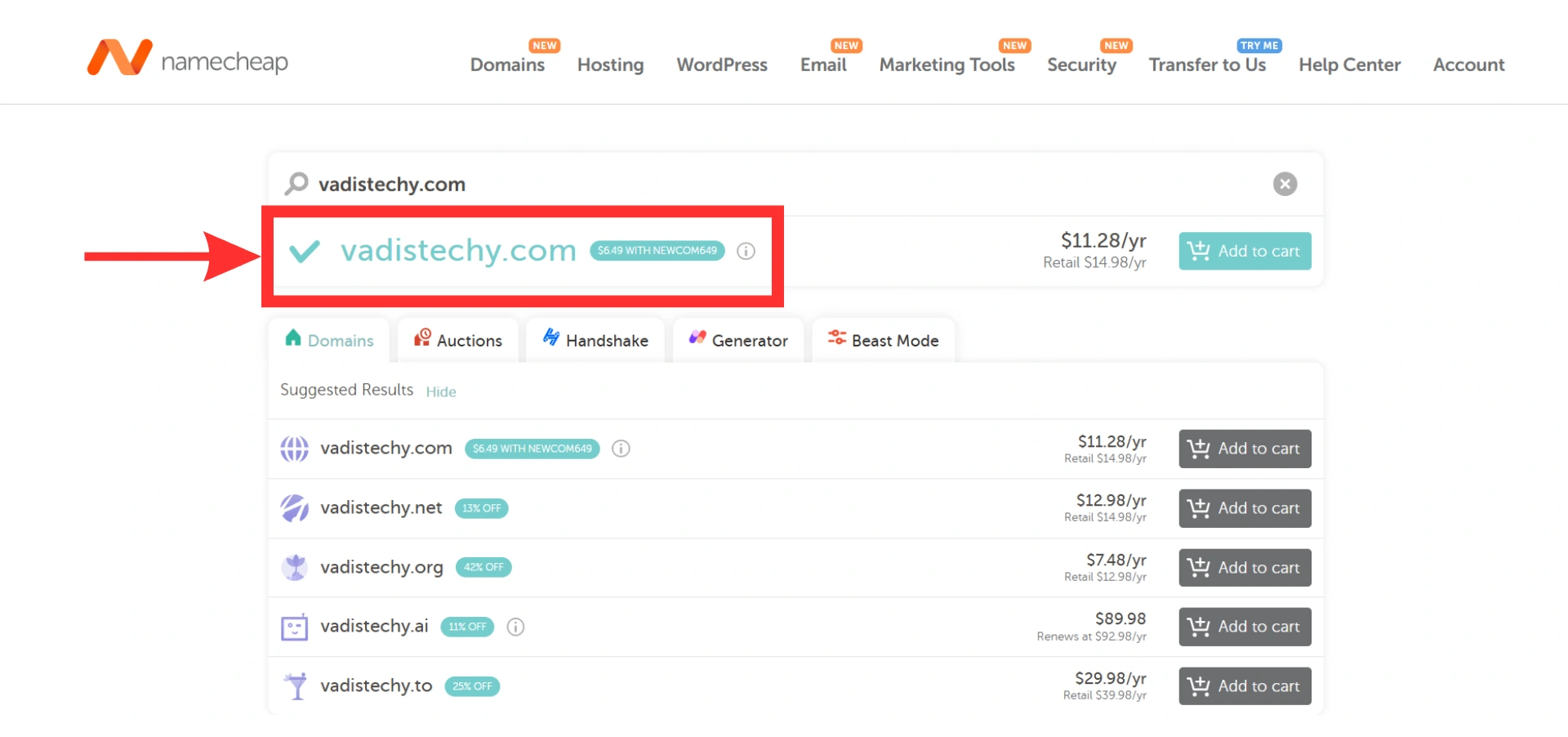
Extra Tips:
- Stick with (.com) if you can. It’s still the most trusted and remembered.
- Avoid brand names or trademarks in the domain (no “googletools” or “applehelp”)
- Keep it under 15 characters if possible
Vadis should pick a name he’s proud to say out loud, easy to type, and flexible enough to let his brand grow without feeling boxed in.
2. Hosting
This is where your site lives. I strongly recommend WPX Hosting. Yeah, it’s more expensive than budget hosts…but it’s fast, secure, and their customer support is honestly unmatched.
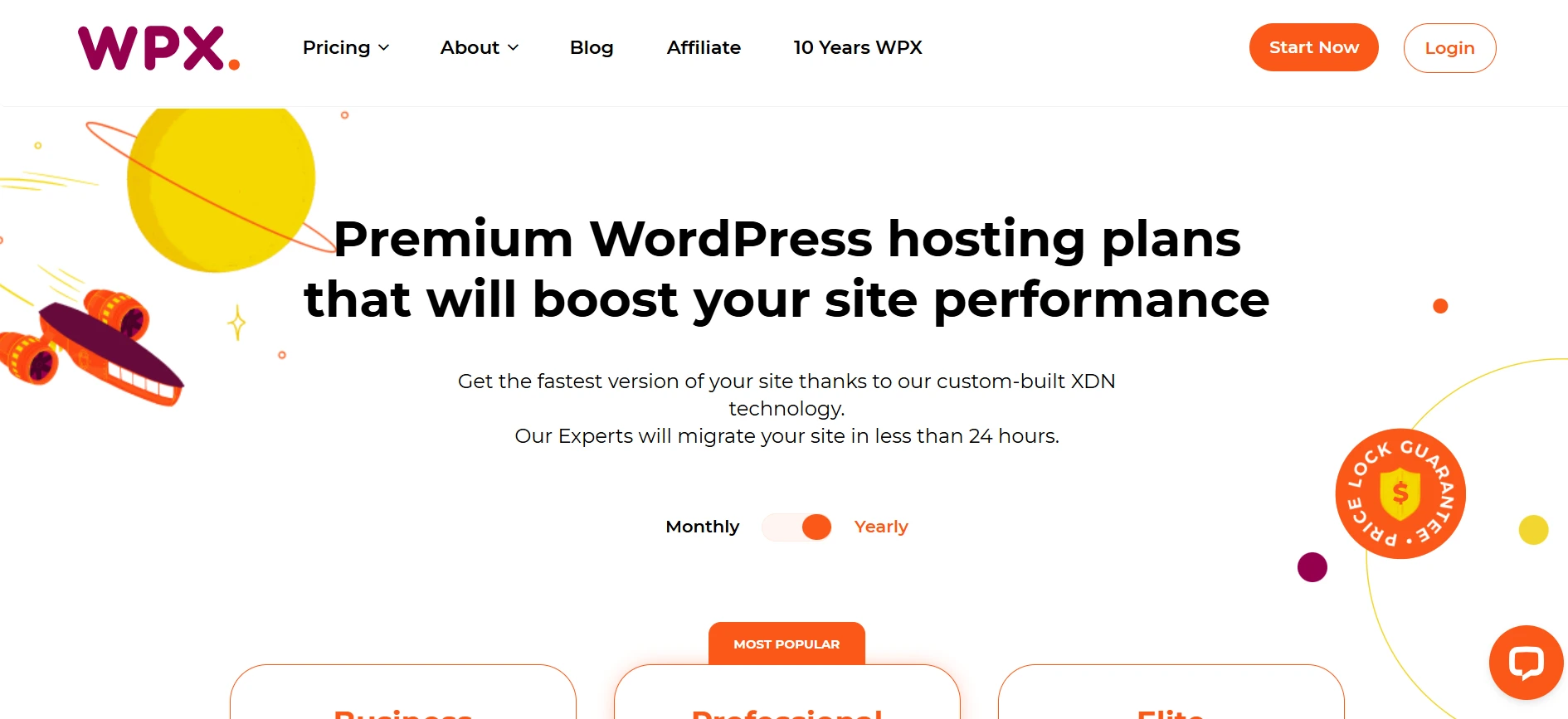
WPX is a managed WordPress hosting provider, which means they handle most of the technical stuff for you. You won’t have to deal with cPanel or dig through confusing settings.
First, Choose the “Business” Plan
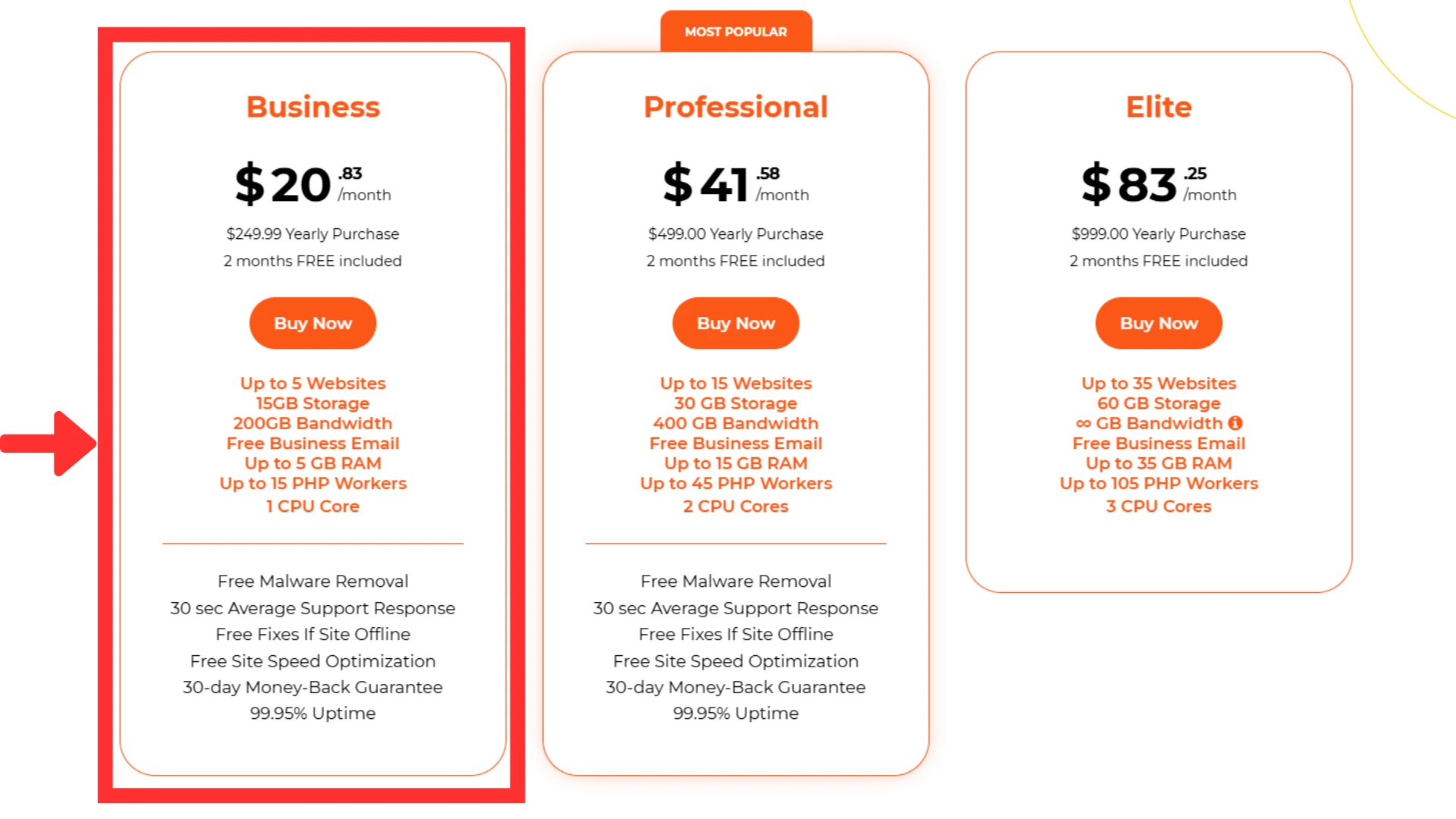
This is perfect for beginners and solo creators.
- You get hosting for up to 5 websites
- Free daily backups
- Built-in speed optimization
- Malware removal (free and included)
For example, with this plan, you can add more sites as you grow. Say you want to include a personal blog or a tools review site for a different audience. That’s easy to do.
Register Your Domain (or Connect One You Own)
During checkout, you can register a new domain or point to a domain you already bought from Namecheap, Google Domains, etc.
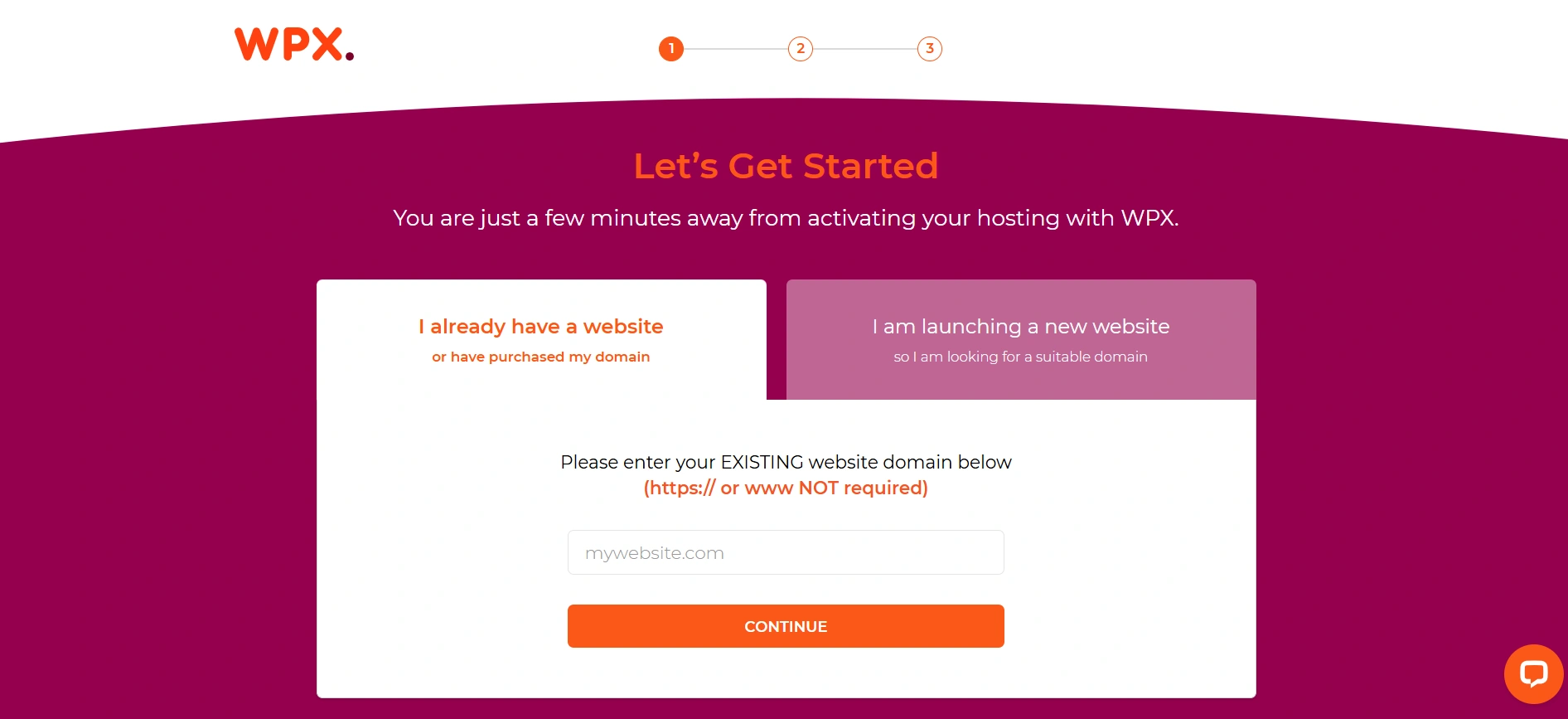
Two cases:
- If Vadis doesn’t have a domain yet, he can register vadistechy.com right on WPX
- If he already bought it from Namecheap, he’ll just update the nameservers (WPX gives him the correct ones)
Pro tip: Even if you register with WPX, it’s still fine. But I prefer keeping domains and hosting separate for flexibility.
Install WordPress (1-click from WPX dashboard)
Once your hosting is active, go to your WPX dashboard and click “Install WordPress.”
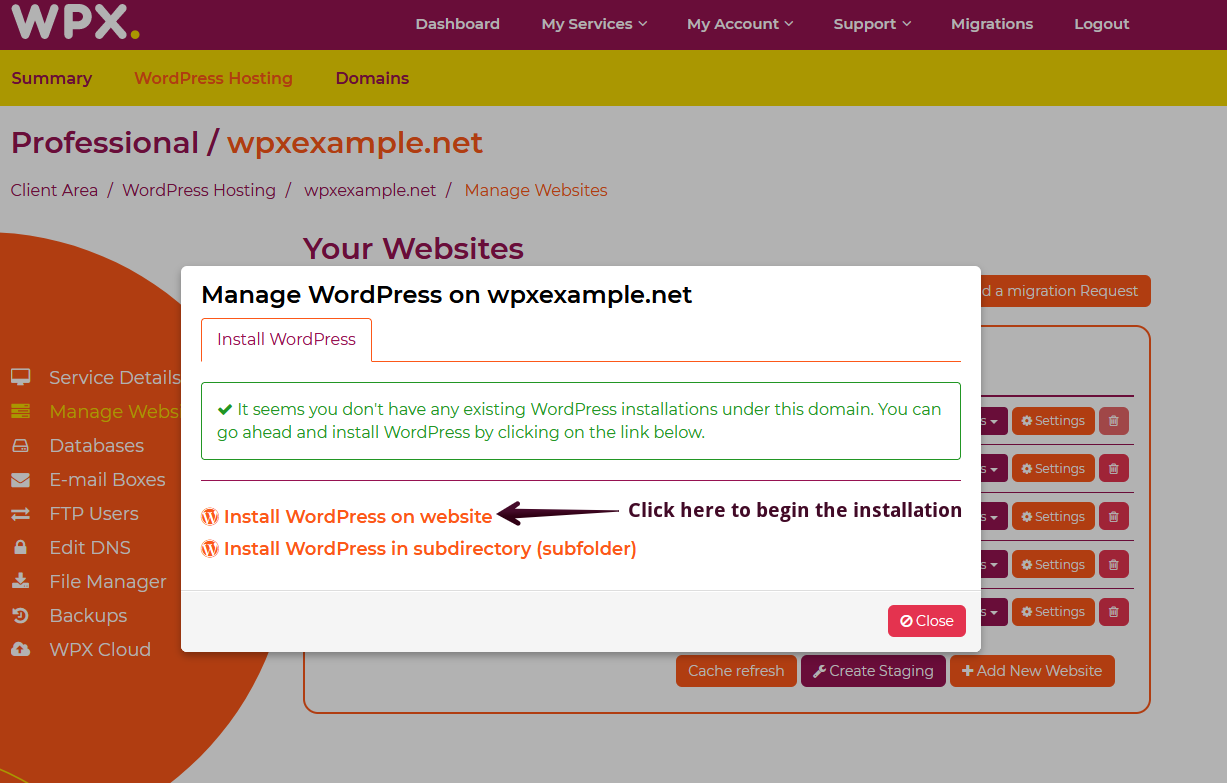
Fill in a few fields (site title, username, password), and you’re live in minutes.
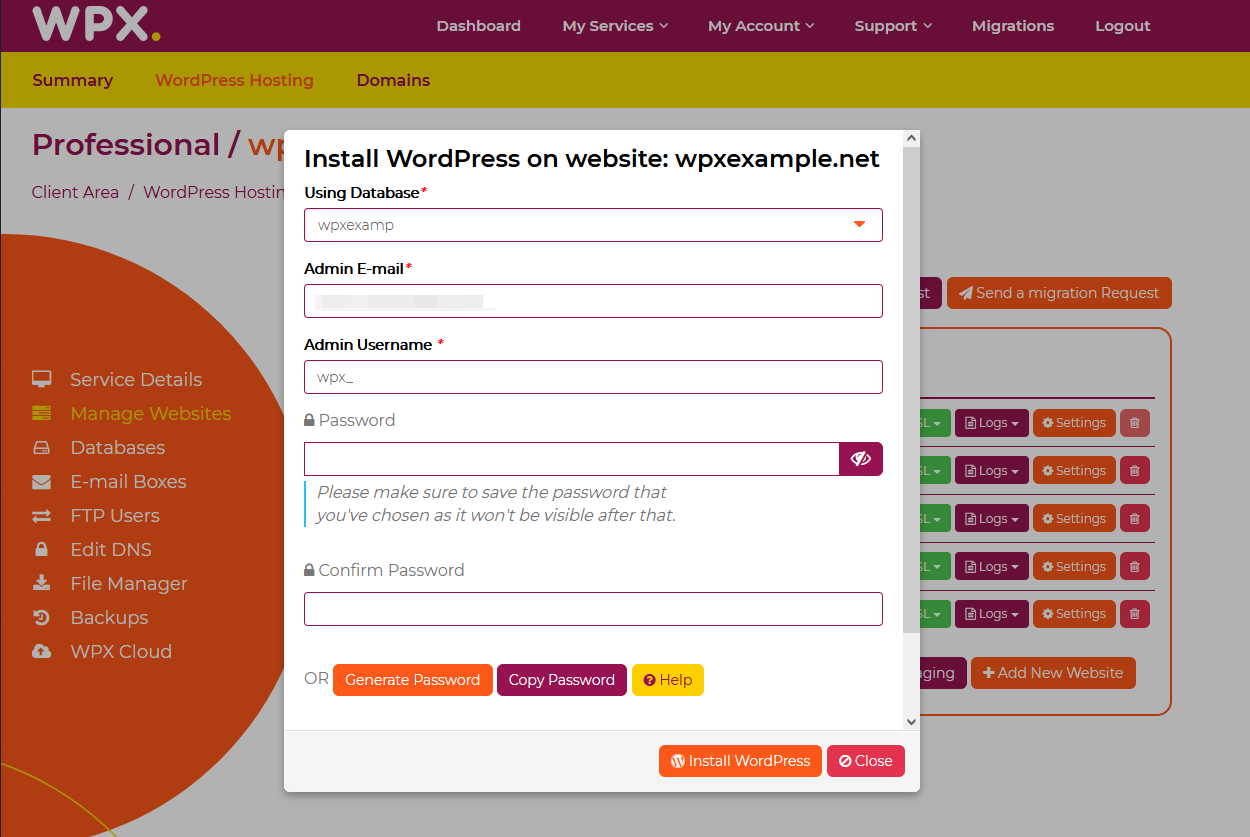
WPX automatically sets up:
- A clean WordPress install
- SSL certificate (so your site is secure with HTTPS)
- Fast caching (via their own WPX Cloud CDN)
For example, Vadis installs WordPress and sees his site live at “vadistechy.com” using the default theme. No coding, no setup headaches. The site is clean, simple, and ready to go.
He can start writing blog posts, upload images, or even add pages. Everything’s laid out for him inside the WordPress dashboard. It’s all point and click.
The importance of using WPX hosting
Speed = Rankings + Conversions
- WPX is known for fast load times. They use SSD servers and their own CDN (content delivery network)
- Google ranks faster sites higher
- Visitors trust fast sites and bounce less
Support That’s Actually Helpful
- WPX live chat responds in under 1 minute
- Their support team doesn’t just point you to articles—they fix things for you
- If you break something or get stuck, they’ll jump in fast
Security and Backups
- Automatic daily backups
- Free malware removal
- Secure servers with firewall protection
This means you don’t need a separate security plugin or a backup plugin. WPX handles it.
3. Theme
This part decides how your site looks and feels. But more importantly, it affects how fast your pages load, how readable your content is, and how easy it is for people to click your links. Don’t overthink it. You just need something clean, fast, and easy to tweak.
Here are my top picks (I’ve used all three):
- Kadence – My personal favorite. Lightweight, flexible, works great with block editors. I use it on most of my sites because it just works. Customizing is simple, even if you’ve never built a site before.
- Astra – Also super fast. Comes with starter templates so you can set up a good-looking layout in minutes. Great if you want something that looks polished without hiring a designer.
- GeneratePress – Another solid choice. Very lightweight, reliable, and beginner-friendly.
What to Do:
- Go to your WordPress dashboard
- Click Appearance → Themes → Add New
- Search for “Kadence” (or Astra, or GeneratePress)
- Click Install, then Activate
That’s it. You now have a solid, conversion-friendly foundation.
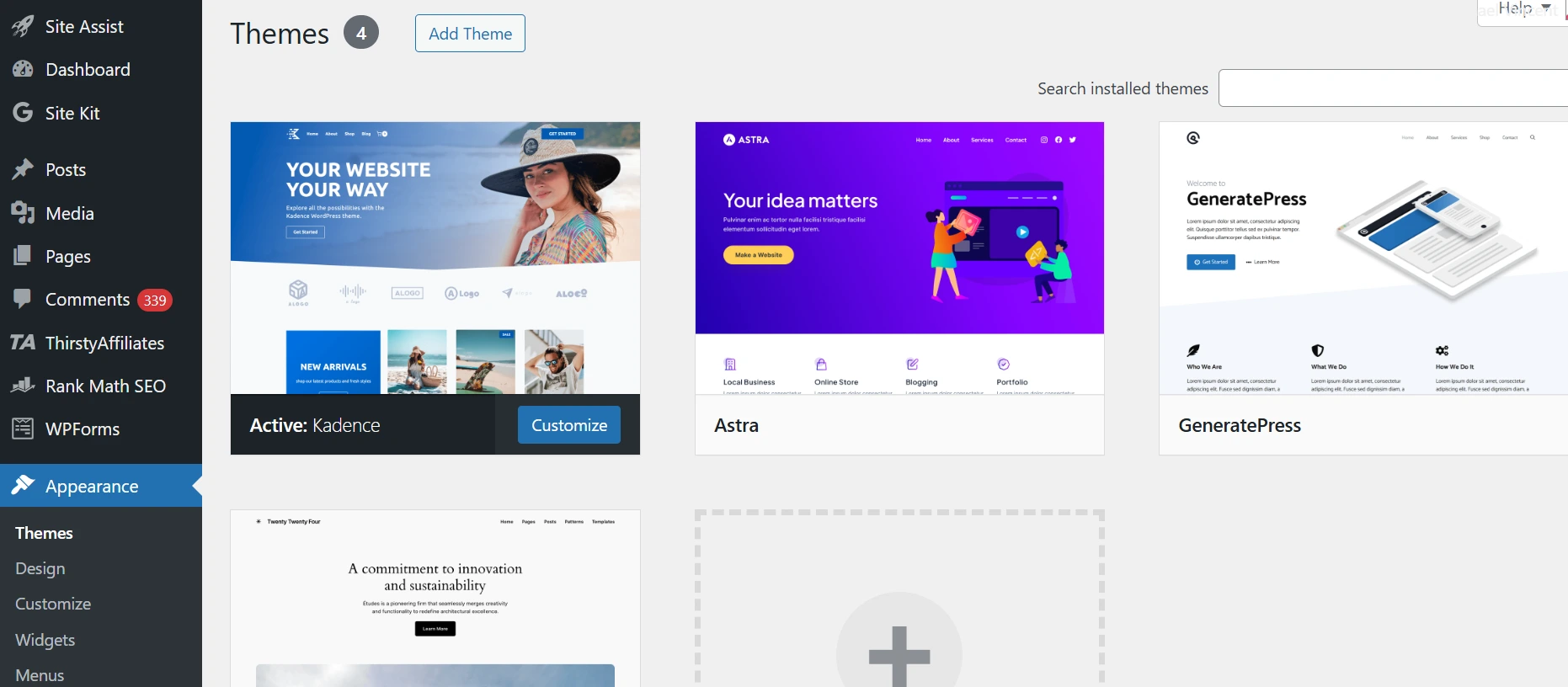
4. Essential WordPress Plugins You Should Install
Once your theme is set, it’s time to add the tools that make your site actually work. Think of plugins like little apps that handle specific jobs—SEO, speed, backups, contact forms, affiliate link tracking. You don’t need a ton. Just a few solid ones to keep things running smooth, fast, and secure.
These are the ones I always install right after setting up a fresh WordPress site.
- Rank Math – Handles your SEO setup and helps your posts rank. Way more intuitive than Yoast.
- WP Rocket – Speeds up your site. Better loading times mean happier visitors (and higher rankings).
- ThirstyAffiliates – Cloaks your affiliate links so they look clean and trackable.
- WPForms – Adds a contact form to your site in seconds.
- UpdraftPlus – Lets you back up your site regularly. If anything breaks, you’re covered.
These tools are battle-tested. They won’t bog your site down. And they give you everything you need to look professional, stay protected, and grow without tech headaches.
Your First Blog Post Strategy (Not “Hello World”)
Honestly, nobody wants to land on your site and see the default “Hello World” post. That’s not just lazy, it makes your blog look like you’re not serious.
Your first post sets the tone. It’s your first impression. So don’t overthink it—just start with something helpful. You want to show two things: you know your stuff, and you’re here to make your readers’ lives easier.
Pick a topic that solves a simple, common problem in your niche. Think of what you were searching for when you first got interested in it. Then write as if you’re talking to someone one step behind you.
Here are a few first-post ideas that actually work:
- “Top 5 Tools I Wish I Had When I Started [your niche]”
Great way to share your experience and recommend affiliate products naturally. - “How to [do something useful] Without Wasting Time or Money”
People want solutions. Keep it direct and practical. - “A Beginner’s Guide to [specific topic] That Actually Makes Sense”
This builds trust with newbies who are overwhelmed and just want clear advice.
The goal here isn’t to cram in links. Add affiliate links only where it makes sense. Focus more on being clear and helpful. Talk like a human, not a salesperson. That’s what builds trust—and trust gets clicks.
You’re not writing for search engines yet. You’re writing for the first real person who lands on your site. Make it feel personal. Like you’re helping a friend.
Once you’ve got this post live, congrats—your site is real. But it won’t matter unless people find it. So next, let’s talk about getting actual traffic. Because no traffic means no clicks, no commissions, no nothing.
Step 4: Create Content That Sells Without Being Pushy
Now that your site is up and running, it’s time to create content—the kind that brings traffic and makes money.
Creating content is where affiliate marketing gets real. This is how you attract the right people, earn their trust, and guide them to the products or services they’re already looking for—without sounding like a desperate salesperson. The key is being helpful, honest, and smart about what you write.
Here’s how to approach it:
Blog Content Types: Reviews, How-Tos, Comparisons
Start with content formats that make sense for recommending products. Reviews are great if you’ve actually used the product. Be honest—what you liked, what you didn’t, who it’s really for. That builds trust fast.
How-to guides are another goldmine. If you can teach someone how to solve a problem—like “How to Start a Blog with WordPress”—you’ve got a natural setup to suggest tools, hosting, themes, and more.
Comparisons are perfect for people close to buying. Think “Systeme.io vs ClickFunnels.” These people want to choose—they just need a little clarity. Show the pros, cons, and what you’d personally go with.
Intent Matters: Informational vs Commercial Keywords
Not every visitor lands on your site ready to click a buy button. Some are just curious. Others are comparing options or just looking for information. A few are primed to make a purchase.
That’s why understanding search intent is very important. It helps you write content that actually connects with what people are looking for.
Informational keywords are things like:
- “What is affiliate marketing”
- “How does SEO work”
These people aren’t ready to spend yet. They’re researching. You can still serve them helpful content and introduce affiliate links gently, but don’t push.
Commercial keywords, though, are different:
- “Best email marketing tool for beginners”
- “WPX Hosting review”
These folks are closer to a buying decision. You can be more direct here—break down features, give honest opinions, and link to the product clearly.
Knowing the intent behind what someone searches is what separates random traffic from clicks that actually convert.
Writing with a Purpose: Teach, Recommend, Invite
Every piece of content should have a clear goal. Are you teaching something? Recommending a product? Inviting them to try a solution?
When you teach, break it down clearly. Use examples. Don’t assume the reader knows what you know.
When you recommend, tell them why. Don’t just drop a link—explain how the product helped you or solved a real problem.
When you invite, give them a reason. Show them what they gain. It could be time saved, money made, frustration avoided.
People don’t need a hard sell—they need a real reason to click.
Where to Place Affiliate Links Naturally
The worst thing you can do is cram links all over the page.
Instead, think about flow. Add your affiliate link:
- Right after you explain how the product helps
- Inside a “Pro Tip” box or callout section
- Once near the top (for skimmers), once in the middle, and once near the end
You’re guiding, not selling. If the link fits the context, it won’t feel pushy. And that’s what gets clicks.
Read Also: How to Add Affiliate Links to Your Blog Naturally Without Sounding Pushy or Salesy
Quick SEO Tip: Rank by Answering Real Questions
SEO sounds like a big, scary thing. But early on, don’t overcomplicate it. Just focus on answering questions people already ask.
Use Google’s “People Also Ask” box. Type in your topic and check the related questions. Use those as headings or inspiration.
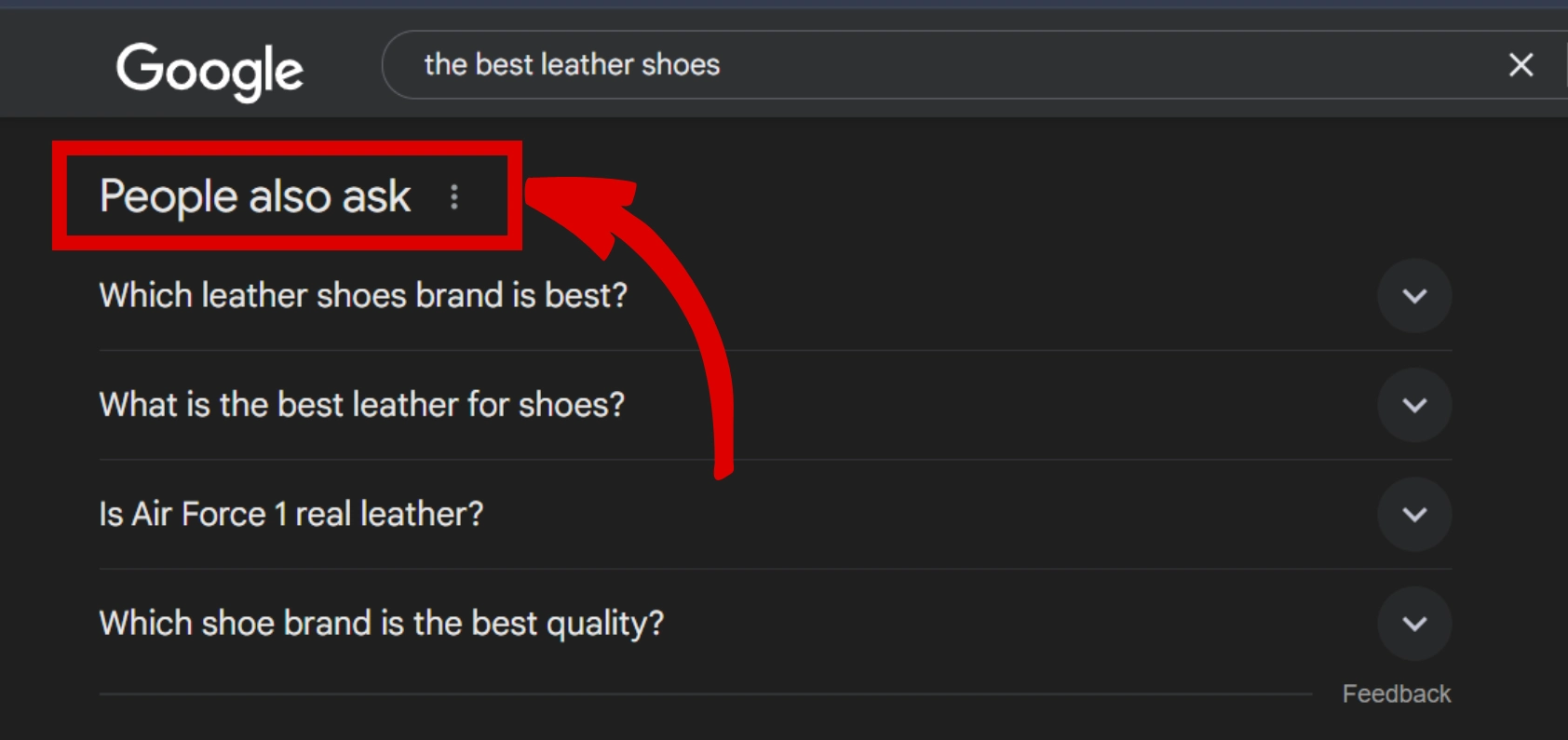
Also, tools like AnswerThePublic or even Reddit threads can help you spot what real people struggle with. If your content is the one that gives them a clear, useful answer, Google will notice. So will your readers.
Step 5: Build Trust and Grow Traffic
You can have the perfect affiliate offer, the best blog design, and smart content—but if people don’t trust you or can’t find you, you won’t make a cent. Affiliate marketing works when people feel like they know you, trust your advice, and keep coming back.
Let’s break down how to build that kind of trust and get people to your content.
Why People Don’t Buy from Random Strangers
The internet is full of noise. Everyone’s pitching something. So, when a stranger lands on your site and sees a link, they won’t click just because it’s there. They’ll ask themselves:
“Who is this person? Why should I listen to them? What’s in it for me?”
That’s why trust matters. People buy from those they feel connected to. Show them you’re real. Share your story. Talk about what worked for you. Be honest about what didn’t. If you’re just another anonymous blog filled with copy-paste content and zero personality, they’ll bounce.
Build the relationship first—sales follow after.
Use of Email Lists, Content Consistency, and Transparency
An email list isn’t optional. It’s your safety net. Social media algorithms can change, SEO rankings can drop—but your email list is yours. Even a small, engaged list can outperform 10x the traffic if your emails feel personal and helpful.
Here’s How to Build a Strong Email List for Your Affiliate Marketing Business
Start building it from day one. Offer a simple lead magnet—like a free checklist or guide. Keep it niche-specific. Once people join, don’t ghost them. Send value-packed emails consistently. Show up weekly if you can.
Also, be transparent in your content. Add an affiliate disclosure note on your blog—just like the one I’ve shared below.

Let readers know when a link is an affiliate link. It won’t scare them off. If anything, it makes you look more trustworthy. And if you only promote products you truly believe in, they’ll trust your links even more.
Organic Traffic Tips: SEO, Pinterest, YouTube
Organic traffic takes time, but it’s free and powerful. Focus on one or two channels in the beginning.
For SEO, start simple:
- Target long-tail keywords (easier to rank) – Use KWFinder to find long-tail keywords
- Optimize titles, URLs, and meta descriptions
- Internally link your posts
- Write for humans, not just search engines
Pinterest works well for visual or lifestyle niches. Create pins for each blog post. Use keywords in your pin titles and descriptions. It can drive hundreds of visitors if you stay consistent.
YouTube is gold for building trust. People see your face or hear your voice—it speeds up the relationship. You don’t need a studio. Just start with tutorials, reviews, or even talking-head videos around your niche. Then link back to your blog or affiliate offer.
Recommended Reading: Best SEO Strategies for Affiliate Websites: How to Get Free Organic Traffic
Paid Traffic Tips (Only After Organic Is Working)
Don’t throw money at ads too early. If your site doesn’t convert, paid traffic will just burn your wallet.
But once you’ve got proven content and a funnel that converts, paid traffic can scale fast. Focus on simple campaigns:
- Google Ads targeting buyer keywords
- Facebook or Instagram ads sending to your lead magnet
- YouTube pre-roll ads if you’re comfortable on camera
Test with small budgets. Track results. Don’t aim for a massive audience—target the right people with the right message. And always send them to a landing page or funnel that builds trust before selling.
Here is an Example of my First Email Funnel That Actually Converted
When I first built my email funnel, it was ugly. Just plain text, no fancy design. But it worked—because it was real.
I offered a free “Affiliate Starter Toolkit” to new readers. Once they signed up, I sent them 5 emails across 5 days:
- Day 1: My personal story (why I started Affiliate marketing)
- Day 2: Common beginner mistakes to avoid
- Day 3: My favorite tools (with honest pros and cons)
- Day 4: A short case study showing how one blog post made $175
- Day 5: Invitation to check out a beginner-friendly course (affiliate offer)
That funnel made my first real passive income. Not from a massive list—just a small one that trusted me. And that trust came from showing up with value, not just offers.
Step 6: Track, Test, and Improve Your Strategy
Most beginners skip this part—but this is where the money actually starts to show. You can’t improve what you don’t measure. Tracking helps you spot what’s working, what’s wasting time, and where to double down. Don’t guess. Watch the data. It tells you everything you need to know.
Use Simple Tools: Google Analytics, Bitly, Affiliate Dashboards
You don’t need a full-blown data lab to track results. Just use the basics.
Google Analytics tells you where your visitors come from, how long they stay, and which pages they bounce from. It helps you see what’s keeping people engaged.
Bitly or other link shorteners are great for tracking specific links—especially in emails or social posts. You’ll know how many clicks each one gets.
Your affiliate dashboards also show important data: clicks, conversion rates, and commissions. Keep an eye on which products convert and which ones just get clicks but no sales. Replace weak ones with stronger offers over time.
The goal here isn’t to obsess over numbers—it’s to make better decisions.
Watch What Content Gets Clicks and Conversions
You might think your favorite blog post is doing well—but the data may tell a different story. Some posts might get tons of views but no clicks. Others may get fewer views but convert better.
Watch for these signs:
- Which posts people spend the most time reading
- Which links are getting clicked (use Pretty Links + Bitly for this)
- Which emails get opened and drive traffic
When you find posts that perform well, double down. Update them. Add more value. Improve the calls to action. Then, use them as models for future content.
Try A/B Testing Calls to Action or Button Placements
Small tweaks can lead to big wins.
Try changing:
- Button colors
- Link placement (top vs. middle vs. bottom)
- Wording on your CTA (like “Check Price” vs. “See My Pick”)
- Email subject lines or preview text
Only test one thing at a time so you know what caused the change. You don’t need fancy tools to A/B test. Just clone the same page or post and run each version with a different traffic source or time period.
Keep it simple: test, watch results, and keep the better version.
Set Realistic Goals (Not $10K in 10 Days)
The internet is full of fake “I made $100K in 3 weeks” stories. Don’t fall for it.
Real affiliate marketing takes time. Set goals that make sense. For example:
- First click: 1 week
- First commission: 30–60 days
- First $100: 90 days
- First $1,000 month: 6–12 months
These aren’t rules, but they’re more real than those wild claims online.
The key is to stay consistent and focused. If a piece of content doesn’t convert, tweak it. If a traffic source isn’t bringing clicks, try another. This step turns a hobby into a business.
Common Mistakes Beginners Make (And How to Avoid Them)
Starting affiliate marketing is exciting. But I’ve seen too many beginners shoot themselves in the foot—either by rushing, copying others blindly, or overcomplicating things. Most of these mistakes are avoidable if you know what to watch for early on. Here’s what often goes wrong and how to do better:
Joining Every Affiliate Program You See
A big mistake I made at the start? Signing up for 20+ programs. I thought more offers meant more chances to earn. In reality, I ended up overwhelmed, promoting too many things half-heartedly.
It’s better to pick 1–3 solid programs that align with your niche and focus your energy there. Stick with tools or products you understand and would recommend even without a commission. Quality over quantity always wins here.
Promoting Random Stuff With No Plan
Some folks post a link today about protein powder, tomorrow it’s web hosting, and next week, a crypto app. It confuses your audience—and kills your credibility.
Before promoting anything, ask: Does this solve a problem my audience cares about? If it doesn’t, skip it. Build content around topics that make sense for your niche and support one another. That’s how trust and sales grow together.
Writing for Google, Not for Humans
Yes, SEO matters. But stuffing keywords and writing robotic blog posts just to rank? It backfires.
People click away fast if it feels fake or unreadable. Google notices that too. Write like you’re helping a friend. Be clear, useful, and honest. The rankings will follow because real value always wins over tricks.
Ignoring Disclaimers (Legal Stuff Matters)
This one’s simple but serious. If you’re making money from links, you must tell your readers. It’s not just best practice—it’s required by the FTC and most affiliate programs.
Add a short disclaimer at the top or bottom of your blog posts:
“Some links in this post are affiliate links. I may earn a small commission if you buy through them, at no extra cost to you.”
It builds trust, keeps you legal, and protects your site from issues later on.
Quitting Too Soon
This is the #1 reason most people fail. They post a few blogs, make no sales, and give up after a month. The truth is, affiliate marketing takes time. You’re planting seeds that grow with consistency.
Your first post might get 10 views. Your second might get none. Keep going anyway. It’s the ones who push through the silence and keep showing up who end up earning years of passive income.
Final Thoughts: Keep It Simple, Keep It Real
Affiliate marketing still works. Not because of tricks, hacks, or secret tools. It works because real people are out there searching for real answers—and if you’re the one who helps them, they’ll trust your recommendations. That’s the heart of it.
You don’t need a perfect website. You don’t need hundreds of posts. You just need to start. Pick a niche, find a couple of solid offers, and create content that’s honest and helpful. That’s how this grows.
If I could go back and give myself one piece of advice? Don’t wait until everything looks perfect. I wasted weeks tweaking my logo while others were writing content and building traffic. Start messy, learn as you go, and keep showing up. Progress beats perfection every time.
If you’re ready to go deeper and want help staying on track, I created a free 7-day email course that walks you through the exact steps I’d take if I had to start from scratch today. You’ll get daily lessons, practical tips, and a roadmap that skips the fluff.
👉 Click here to join the 7-Day Affiliate Starter Course
This stuff works. But only if you do.
Frequently Asked Questions
How do I start affiliate marketing with no money?
You don’t need cash to get started. Just time, consistency, and a smart plan. Use free tools. Start with platforms like Medium, LinkedIn, or a free WordPress.com blog to post content. Don’t wait to build a website if that’s out of reach right now.
Focus on providing value. Use social media like Instagram, TikTok, Pinterest, or YouTube to share content that solves real problems. Find affiliate programs that are free to join, like Amazon Associates or ClickBank.
Then, create content around those products—reviews, how-tos, or tips that help people. You don’t need a camera crew or fancy tools. Your phone and your voice are enough. Just be clear, honest, and helpful.
Over time, as you get traffic and clicks, reinvest the commissions into your own domain and hosting. Start scrappy—grow smart.
How long does it take to make money with affiliate marketing?
It depends on how fast you take action and how consistent you are. Some people earn their first commission within the first 30 to 90 days—but only if they actually publish content and promote it. If you’re just watching tutorials and tweaking your site without posting anything, it’ll take much longer.
Focus on solving real problems. One blog post that ranks or one TikTok that goes viral can bring in that first sale. But affiliate marketing compounds. Your early efforts may feel slow, but they build momentum.
Think of it like planting seeds. If you keep watering them with helpful content and solid keywords, the results will show. Just don’t stop too early. Most people quit right before things start working. If you stick with it for three to six months and stay focused, you’ll likely start seeing steady traffic and conversions.
Do I need a website to do affiliate marketing?
No, but having one helps a lot. You can start promoting affiliate links on platforms like YouTube, TikTok, Instagram, or even email. But a website gives you control—it’s your home base. Social platforms change their rules, ban accounts, or throttle reach.
A website doesn’t. It also builds trust. People are more likely to click and buy from someone who looks established. You can create evergreen content, rank on Google, and keep earning from old posts. Even a simple blog with 5 to 10 solid posts can do the job.
Think of it this way: social media is fast, but a website is reliable. I’ve made money from posts I wrote two years ago, all because they still rank. So while you don’t need one to start, I always suggest building one once you’re serious.
Is affiliate marketing legal?
Yes, affiliate marketing is completely legal—as long as you’re honest about it. The big rule is disclosure. You need to tell your audience when a link could earn you a commission. It’s not optional—it’s required by the FTC in many countries, including the U.S. And it’s not just for websites.
If you’re sharing affiliate links on YouTube, TikTok, or even inside an email, you still need to disclose it. A simple sentence like “This post contains affiliate links. If you buy through them, I may earn a small commission at no extra cost to you” is enough. Some people worry that disclosure will scare readers away.
In my experience, it does the opposite. It builds trust. People appreciate honesty, and when you only recommend products you truly believe in, your transparency makes you look more legit. Legal? Yes. But honest and helpful? That’s what really makes it work.
Which affiliate programs are best for beginners?
If you’re just starting, go with programs that are easy to join, free, and have plenty of products to promote. A few solid options like:
Amazon Associates is the go-to for beginners. Almost everyone shops on Amazon, and they sell just about everything. The commissions aren’t huge, but it’s simple to use, and people already trust the platform.
ShareASale is another good one. It’s a big affiliate network with thousands of programs in one place. You can find offers in health, fashion, software, home goods—you name it. You apply once, and then you can apply to individual merchants inside the dashboard.
Impact and ClickBank are great if you’re leaning toward digital products or software. Impact works with big brands, and ClickBank has tons of info products (ebooks, courses, etc.).
Start with just 1–2. Don’t try to join 20 at once. Keep it simple and focused.
Can I do affiliate marketing on YouTube or Instagram?
Yes, and a lot of people do it successfully without ever building a website. The key is understanding how each platform works with affiliate links.
On YouTube, you can add affiliate links in your video descriptions. Just make sure to mention that in the video. Say something like, “This video contains affiliate links—I may earn a small commission if you buy through them.” Simple. No one minds if you’re upfront.
For Instagram, you’ll need a business or creator account to add a link in your bio. Since Instagram doesn’t allow clickable links in regular post captions, you can use a service like Linktree to combine all your links in one place. Then direct people to that one link from your posts or Stories.
Just follow the platform rules and be transparent. You don’t need a site to start. Content and trust matter more.
How do I get traffic to my affiliate links?
You need eyeballs before you get clicks. And not just any eyeballs—people who actually want what you’re talking about.
Start with helpful content. Think blog posts, YouTube videos, Pinterest pins, or TikToks that answer real questions. For example, “Best laptops under $500 for students” or “How to fix slow Wi-Fi without buying new gear.” These kinds of posts attract people who are ready to take action.
If you like writing, go with a blog. If you prefer video, YouTube is gold. Pinterest works great for visual stuff like DIY, health, or beauty. TikTok is fast-paced but powerful when your content clicks.
Whatever platform you choose, focus on being useful first. Solve problems. Be real. Add affiliate links where they naturally make sense—don’t just drop links hoping someone clicks.
Organic traffic takes time, but it compounds. Once you build trust, the clicks and commissions follow.
Do I have to pay to join affiliate programs?
No. Legit affiliate programs are always free to join.
If a site asks you to pay just to apply, walk away. That’s usually a scam. Real programs want you to promote their stuff and they don’t charge you for that. Think about it: you’re helping them make sales. Why would they ask you for money?
Big names like Amazon Associates, Impact, or ShareASale? All free. Same with ClickBank, Digistore24, and most SaaS affiliate programs. What matters is the quality of the product and how well it fits your audience.
Some tools (like website builders or email software) do have affiliate programs, but again, the program itself should cost nothing to join. You only pay for the product if you choose to use it.
If they want your card details just to “apply,” skip it. Focus on trusted platforms that value good content and honest recommendations.
Can I do affiliate marketing without showing my face?
Yes, you can, and many people do.
Not everyone wants to be on camera, and that’s fine. You don’t need to be the face of your brand to earn with affiliate marketing. You can run a blog, create voice-over videos, post carousel content on Instagram, or make faceless YouTube videos using tools like Canva or AI video editors. TikTok has entire pages that never show a face but still pull in views and clicks.
What matters is the value you give, not your selfie game. If your content helps people solve a problem or make a smart decision, they’ll click—face or no face. Focus on clarity, honesty, and usefulness.
Some niches even perform better without personality-driven branding. Tech reviews, finance, product roundups—these can all work anonymously. Just build trust with solid info and a clean setup.
How do I track my affiliate earnings?
Tracking your affiliate earnings isn’t hard—most affiliate programs handle the heavy lifting.
Every legit program gives you a dashboard. That’s where you’ll see clicks, conversions, and commissions in real time. Whether you’re using Amazon, ShareASale, or Impact, they’ll show you what’s working and what’s not.
But if you want more control, use tools like Pretty Links or Bitly. These let you track link clicks, even outside the affiliate platform. For example, you can see which blog post or YouTube description is sending the most traffic. That helps you double down on what’s getting attention.
I check my stats weekly. If a link’s getting clicks but no conversions, I dig into it. Maybe the page isn’t strong enough, or maybe the product just doesn’t convert. Tracking gives you the data to adjust and improve.
Want a bonus tip? Use Google Analytics with custom events to track deeper behavior. It takes a bit to set up, but once it’s running, you’ll see what content actually leads to money

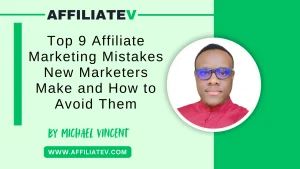

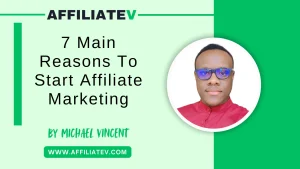
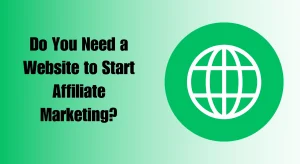
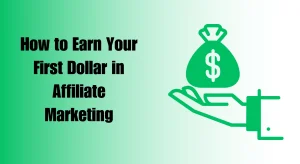
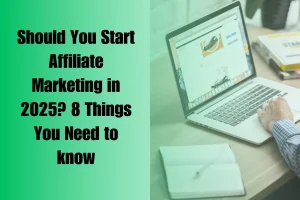
Your writing is a true testament to your expertise and dedication to your craft. I’m continually impressed by the depth of your knowledge and the clarity of your explanations. Keep up the phenomenal work!